Two tigers rearing on their hindlegs standing face to face.
Glyph: tiger: kola ‘tiger’. Rebus: kol ‘working in iron’
Glyph: dula ‘pair’. Rebus: dul ‘casting (metal)
![]()
![]()
![]() Copper ox-hide ingot. Orthographically, the ingot is a mould with large, curving horns. This was also shown carried by Egyptians on a painting. A Cretan ox-hide ingot also had an incised glyph: Sarasvati hieroglyph of kolom 'graft' rebus: kolami 'smithy, forge'. Inscribed Cretan copper ox-hide ingot (After Fig.82 in: Sinclair Hood, 1971, The Minoans: Crete in the Bronze Age, Thames and Hudson) In the Late Bronze Age, oxhide and plano-convex shaped ingots were used in the Aegean; elsewhere, only small plano-convex (bun-shaped) ingots were used."Bronze tools and weapons were cast in double moulds. The cire perdue process was evidently employed for the sockets of the fine decorated spear-heads of the Late Minoan period. Copper was available in some parts of Crete, notably in the Asterousi mountains which border the Mesara plain on the south, but it may have been imported from Cyprus as well. The standard type of ingot found throughout the East Mediterranean in the Late Bronze Age was about two or three feet long, with inward-curving sides and projections for a man to grasp as he carried it on his shoulder. Smaller bun-shaped ingots were also in use." (Sinclair Hood, opcit., p. 106). A variant of the inscribed sign, a comparable logograph, like a trident or a sheaf of corn, is used in Sarasvati hieroglyphs.
Copper ox-hide ingot. Orthographically, the ingot is a mould with large, curving horns. This was also shown carried by Egyptians on a painting. A Cretan ox-hide ingot also had an incised glyph: Sarasvati hieroglyph of kolom 'graft' rebus: kolami 'smithy, forge'. Inscribed Cretan copper ox-hide ingot (After Fig.82 in: Sinclair Hood, 1971, The Minoans: Crete in the Bronze Age, Thames and Hudson) In the Late Bronze Age, oxhide and plano-convex shaped ingots were used in the Aegean; elsewhere, only small plano-convex (bun-shaped) ingots were used."Bronze tools and weapons were cast in double moulds. The cire perdue process was evidently employed for the sockets of the fine decorated spear-heads of the Late Minoan period. Copper was available in some parts of Crete, notably in the Asterousi mountains which border the Mesara plain on the south, but it may have been imported from Cyprus as well. The standard type of ingot found throughout the East Mediterranean in the Late Bronze Age was about two or three feet long, with inward-curving sides and projections for a man to grasp as he carried it on his shoulder. Smaller bun-shaped ingots were also in use." (Sinclair Hood, opcit., p. 106). A variant of the inscribed sign, a comparable logograph, like a trident or a sheaf of corn, is used in Sarasvati hieroglyphs. d.abe, d.abea ‘large horns, with a sweeping upward curve, applied to buffaloes’ (Santali)
d.ab, d.himba, d.hompo ‘lump (ingot?)’, clot, make a lump or clot, coagulate, fuse, melt together (Santali) d.himba = become lumpy, solidify; a lump (of molasses or iron ore, also of earth); sadaere kolheko tahe_kanre d.himba me~r.he~t reak khan.d.ako bena_oet tahe_kana_ = formerly when the Kolhes were here they made implements from lumps of iron (Santali)
![]() m1429 a
m1429 a
m1429 prism tablet. Boat glyph as a Sarasvati hieroglyph on a tablet.Three sided molded tablet. One side shows a flat bottomed boat with a central hut that has leafy fronds at the top of two poles. Two birds sit on the deck and a large double rudder extends from the rear of the boat. On the second side is a snout nosed gharial with a fish in its mouth. The third side has eight glyphs of the Indus script.
Side b has two birds, two trees ligatured to a boat, two ox-hide ingots infixed in the central hut on the boat ![]()
The hieroglyphs are: side a: eight sign glyphs including: body, rim of jar, two ingots, rim of jar, fish, three, graft infix ligature in ingot.side b: boat, two trees, two birds; side b: gharial (alligator), fish; Boat: kolam; rebus: kolami 'furnace'
Side a has a two-part message:
Body (of person): komor, kombor 'body' (Munda etyma); rebus: kamar 'smith' (Santali)
Rim of jar: kan.d. kan-ka; rebus: kand. 'fire-altar, furnace' (Santali); kan- 'copper' (Ta.)
Two ingots: d.ha_l = a shield, a buckler; the grand flag of an army directing its march and encampments; the standard or banner of a chieftain; a flag flying on a fort (G.); rebus: d.ha_l.ako = large metal ingot (G.) barea 'two'; rebus: barea 'merchant' (Santali)
Rim of jar: kan.d. kan-ka; rebus: kand. 'fire-altar, furnace' (Santali); kan- 'copper' (Ta.)
Fish: kolli 'fish'; rebus: kol 'pancaloha, alloy of five metals' (Ta.)
Three (linear strokes): t.ebra 'three'; ta(m)bra 'copper' graft infixed in an ingot: d.ha_l = shield; rebus: d.ha_l.ako 'ingot'; kolom 'graft'; kolami 'smithy, forge' (Te.)
The eighth (last glyph) from l. is: kolom = cutting, graft; to graft, engraft, prune; kolom dare kana = it is a grafted tree; kolom ul = grafted mango; kolom gocena = the cutting has died; kolom kat.hi hor.o = a certain variety of the paddy plant (Santali); kolom (B.); kolom mit = to engraft; kolom porena = the cutting has struck root; kolom kat.hi = a reed pen (Santali.lex.) ku_l.e stump (Ka.) [ku_li = paddy (Pe.)] xo_l = rice-sheaf (Kur.) ko_li = stubble of jo_l.a (Ka.); ko_r.a = sprout (Kui.)ko_le = a stub or stump of corn (Te.)(DEDR 2242). kol.ake, kol.ke, the third crop of rice (Ka.); kolake, kol.ake (Tu.)(DEDR 2154)kolma = a paddy plant; kolma hor.o ‘ a variety of rice plant’ (Santali.lex.) [kural = corn-ear (Ta.)] Rebus: kolami 'smithy, forge'.
![]()
![]() Reverse side of moulded tablet H-172 Harappa
Reverse side of moulded tablet H-172 Harappa![]() Reverse side of moulded tablet M-482 Mohenjo-daro
Reverse side of moulded tablet M-482 Mohenjo-daro
boat: kola 'boat'; rebus: kol 'pancaloha, alloy of five metals'; bagalo = an Arabian merchant vessel (G.) bagala = an Arab boat of a particular description (Ka.); bagala_ (M.); bagarige, bagarage = a kind of vessel (Ka.); rebus: ban:gala = a portable stove (Te.) = kumpat.i = an:ga_ra s'akat.i_ = a chafing dish, a portable stove, a goldsmith's portable furnace (Te.) cf. ban:ga_ru, ban:ga_ramu 'gold' (Te.) Two birds: bat.a 'bird'; barea 'two' Rebus: barea 'merchant'
bat.a = a kind of iron (G.lex.) bhat.a = a furnace, a kiln; it.a bhat.a a brick kiln (Santali)
On either end of the central hut on the boat are two tree. kut.i 'tree'; kut.hi 'smelter furnace' (Santali)
Side c
fish + gharial: Hieroglyphs: aya 'fish'; karA 'crocodile; Rebus: ayakara 'blacksmith'
kolime, kolume, kulame, kulime, kulume, kulme fire-pit, furnace (Ka.); kolimi furnace (Te.); pit (Te.); kolame a very deep pit (Tu.); kulume kanda_ya a tax on blacksmiths (Ka.); kol, kolla a furnace (Ta.) kole.l smithy, temple in Kota village (Ko.); kwala.l Kota smithy (To.); konimi blacksmith; kola id. (Ka.); kolle blacksmith (Kod.); kollusa_na_ to mend implements; kolsta_na, kulsa_na_ to forge; ko_lsta_na_ to repair (of plough-shares); kolmi smithy (Go.); kolhali to forge (Go.)(DEDR 2133).] kolimi-titti = bellows used for a furnace (Te.lex.) kollu- to neutralize metallic properties by oxidation (Ta.) kol = brass or iron bar nailed across a door or gate; kollu-t-tat.i-y-a_n.i large nail for studding doors or gates to add to their strength (Ta.lex.) kollan--kamma_lai < + karmas'a_la_, kollan--pat.t.arai, kollan-ulai-k-ku_t.am blacksmith's workshop, smithy (Ta.lex.) cf. ulai smith's forge or furnace (Na_lat.i, 298); ulai-k-kal.am smith's forge; ulai-k-kur-at.u smith's tongs; ulai-t-turutti smith's bellows; ulai-y-a_n.i-k-ko_l smith's poker, beak-iron (Ta.lex.) [kollulaive_r-kan.alla_r: nait.ata. na_t.t.up.); mitiyulaikkollan- mur-iot.ir.r.an-n-a: perumpa_)(Ta.lex.) Temple; smithy: kol-l-ulai blacksmith's forge (kollulaik ku_t.attin-a_l : Kumara. Pira. Ni_tiner-i. 14)(Ta.lex.) cf. kolhua_r sugarcane milkl and boiling house (Bi.); kolha_r oil factory (P.)(CDIAL 3537). kulhu ‘a hindu caste, mostly oilmen’ (Santali) kolsa_r = sugarcane mill and boiling house (Bi.)(CDIAL 3538).
sattu (Tamil), satta, sattva (Kannada) jasth जसथ् ।रपु m. (sg. dat. jastas ज्तस), zinc, spelter; pewter; zasath ् ज़स््थ् ्or zasuth ज़सुथ ्। रप m. (sg. dat. zastas ु ज़्तस),् zinc, spelter, pewter (cf. Hindī jast). jastuvu; । रपू्भवः adj. (f. jastüvü), made of zinc or pewter.(Kashmiri). Hence the hieroglyph: svastika repeated five times. Five svastika are thus read: taṭṭal sattva Rebus: zinc (for) brass (or pewter). *ṭhaṭṭha1 ʻbrassʼ. [Onom. from noise of hammering brass?]N. ṭhaṭṭar ʻ an alloy of copper and bell metal ʼ. *ṭhaṭṭhakāra ʻ brass worker ʼ. 1.Pk. ṭhaṭṭhāra -- m., K. ṭhö̃ṭhur m., S. ṭhã̄ṭhāro m., P. ṭhaṭhiār, °rā m.2. P. ludh. ṭhaṭherā m., Ku. ṭhaṭhero m., N. ṭhaṭero, Bi. ṭhaṭherā, Mth. ṭhaṭheri, H.ṭhaṭherā m.(CDIAL 5491, 5493).
m1429B and two other tablets showing the typical composite hieroglyph of fish + crocodile. Glyphs: crocodile + fish ayakāra ‘blacksmith’ (Pali) kāru a wild crocodile or alligator (Telugu) aya 'fish' (Munda) The method of ligaturing enables creation of compound messages through Indus writing inscriptions. kārua wild crocodile or alligator (Telugu) Rebus: khar ‘blacksmith’ (Kashmiri); kāru ‘artisan’ (Marathi).
Pali: ayakāra ‘iron-smith’. ] Both ayaskāma and ayaskāra are attested in Panini (Pan. viii.3.46; ii.4.10). WPah. bhal. kamīṇ m.f. labourer (man or woman) ; MB. kāmiṇā labourer (CDIAL 2902) N. kāmi blacksmith (CDIAL 2900).
Kashmiri glosses:
khār 1 खार् । लोहकारः m. (sg. abl. khāra 1 खार; the pl. dat. of this word is khāran 1 खारन्, which is to be distinguished from khāran 2, q.v., s.v.), a blacksmith, an iron worker (cf. bandūka-khār, p. 111b, l. 46; K.Pr. 46; H. xi, 17); a farrier (El.). This word is often a part of a name, and in such case comes at the end (W. 118) as in Wahab khār, Wahab the smith (H. ii, 12; vi, 17). khāra-basta khāra-basta खार-बस््त । चर्मप्रसेविका f. the skin bellows of a blacksmith. -büṭhü -ब&above;ठू&below; । लोहकारभित्तिः f. the wall of a blacksmith's furnace or hearth. -bāy -बाय् । लोहकारपत्नी f. a blacksmith's wife (Gr.Gr. 34). -dŏkuru लोहकारायोघनः m. a blacksmith's hammer, a sledge-hammer. -gȧji or -güjü - लोहकारचुल्लिः f. a blacksmith's furnace or hearth. -hāl -हाल् । लोहकारकन्दुः f. (sg. dat. -höjü -हा&above;जू&below;), a blacksmith's smelting furnace; cf. hāl 5. -kūrü लोहकारकन्या f. a blacksmith's daughter. -koṭu - लोहकारपुत्रः m. the son of a blacksmith, esp. a skilful son, who can work at the same profession. -küṭü लोहकारकन्या f. a blacksmith's daughter, esp. one who has the virtues and qualities properly belonging to her father's profession or caste. -më˘ʦü 1 - लोहकारमृत्तिका f. (for 2, see [khāra 3] ), 'blacksmith's earth,' i.e. iron-ore. -nĕcyuwu लोहकारात्मजः m. a blacksmith's son. -nay -नय् । लोहकारनालिका f. (for khāranay 2, see [khārun] ), the trough into which the blacksmith allows melted iron to flow after smelting. -ʦañĕ । लोहकारशान्ताङ्गाराः f.pl. charcoal used by blacksmiths in their furnaces. -wānवान् । लोहकारापणः m. a blacksmith's shop, a forge, smithy (K.Pr. 3). -waṭh -वठ् । आघाताधारशिला m. (sg. dat. -waṭas -वटि), the large stone used by a blacksmith as an anvil.
Thus, kharvaṭ may refer to an anvil. Meluhha kāru may refer to a crocodile; this rebus reading of the hieroglyph is.consistent with ayakāra ‘ironsmith’ (Pali) [fish = aya (G.); crocodile = kāru (Telugu)]
![]()
The drummer hieroglyph is associated with svastika glyph on this tablet (har609) and also on h182A tablet of Harappa with an identical text.
dhollu ‘drummer’ (Western Pahari) Rebus: dul ‘cast metal’. The 'drummer' hieroglyph thus announces a cast metal. The technical specifications of the cast metal are further described by other hieroglyphs on side B and on the text of inscription (the text is repeated on both sides of Harappa tablet 182).
kola 'tiger' Rebus: kol 'alloy of five metals, pancaloha' (Tamil). ḍhol ‘drum’ (Gujarati.Marathi)(CDIAL 5608) Rebus: large stone; dul ‘to cast in a mould’. Kanac ‘corner’ Rebus: kancu ‘bronze’. dula 'pair' Rebus: dul 'cast metal'. kanka ‘Rim of jar’ (Santali); karṇaka rim of jar’(Skt.) Rebus:karṇaka ‘scribe’ (Telugu); gaṇaka id. (Skt.) (Santali) Thus, the tablets denote blacksmith's alloy cast metal accounting including the use of alloying mineral zinc -- satthiya 'svastika' glyph.
![]()
Harapan period c 1900 BCE burial urn. Delhi museum.
Peacocks and stars with the image of a person in cartouche. Funerary urn of Late Harappan Cemetery H at Harappa. After Piggott 1950: 234, fig. 29
![]() Burial urn. Cemetery H. Harappa. National Museum, India.
Burial urn. Cemetery H. Harappa. National Museum, India.![]() Harappa. Burial urn. Kenoyer Slide 164
Harappa. Burial urn. Kenoyer Slide 164
![]() Figure of a person is ligatured within the body of the peacock with a wavy plume (first peacock on the right); The person shown within the circle is probably the depiction of the departed a_tman, who has, after cremation, become an ancestor. The stylized depiction of the arms is paralleled by the stylized depiction of arms (or horns?) of the copper anthropomorphs found in Copper Hoard Culture.
Figure of a person is ligatured within the body of the peacock with a wavy plume (first peacock on the right); The person shown within the circle is probably the depiction of the departed a_tman, who has, after cremation, become an ancestor. The stylized depiction of the arms is paralleled by the stylized depiction of arms (or horns?) of the copper anthropomorphs found in Copper Hoard Culture.
The Munda word for peacock *mara'k/mara "cryer > peacock", later Sanskrit ma_ra (and Pali etc) 'death, God Death', the Munda peacock symbol = death, and the Cemetery H peacock pictures on urns with cremated bodies.
Peacock and heaven (marak = peacock; merxa_ = sky, heaven ?may the soul go to heaven); Parji. marp- (mart-)= to lighten; Kurux. merxa_ = sky, heaven; Malto. mergu = sky, heaven; see Te. mer_umu = flash of lightning.
(marak = peacock; sma_raka = remembrance; ji_van-ji_vaka = cry of the peacock, peacock; living, the dead goes with life).
Rebus: लोह -मारक a. calcining a metal.लोह lōha Made of copper, coppery. -3 Made of iron; भ्रमतश्च वराहस्य लोहस्य प्रमुखे समम् Mb.1. 135.23. -हः, -हम् 1 Copper. -2 Iron. -3 Steel. -4 Any metal; वस्तून्योषधयः स्नेहा रसलोहमृदो जलम् Bhāg.2. 6.24. -5 Gold; यथा सौम्यैकेन लोहमणिना Ch. Up.6.1.-(Samskritam)
Hieroglyph: तार tāra A star or planet; (said to be f. also). -2 The pupil of the eye (Samskritam)
Rebus: तार tāra -रम् 1 Silver; तारहेममहारत्नविमानशतसङ्- कुलम् Bhāg.4.6.27-अरिः a pyritic ore of iron.-माक्षिकम् a kind of inferior metal.-हेमाभम् N. of a metal.(Samskritam)
(After Fig. 16.3 Parpola, 2015 ibid.) Kot Diji type seals. a. Taraqai Qila-2 b. Taraqai Qila -3 c. H 638 from Harappa d. H-1535 from Harappa.
Rahman Dheri seal. Rays around concentric circles. After Durrani, Ali & Erdosy 1994-1995: 207
After C. Jarrige et al 1995:160. 'The sun in the four quadrants' painted on a Faiz Mohammad style gray-ware bowl from Mehrgarh, period VI (c. 3200-2900 BCE).
Hieroglyph: arka 'sun' Rebus: arka, eraka 'copper, gold, moltencast' (Samskritam. Kannada. Tulu)
Hieroglyph: gaNDa 'four' Rebus: kanda 'fire-altar' khaNDa 'metal implements'.
![]() Santali glosses.
Santali glosses.
![]() A hieroglyph on m0304 insription: A खांडा khāṇḍā ‘jag’ infixed inside kanka ‘rim of jar’ glyph is read as the phrase: kaṇḍa kanka, ‘furnace account, scribe’. The rim-of-jar is the most frequently occurring hieroglyph in the corpora of Meluhha hieroglyphs (aka Indus writing). This hieroglyph is read rebus: Glyph: kaṇḍa kanka, 'rim of jar' Rebus: furnace account, scribe. cf. kul -- karṇī m. ʻvillage accountantʼ (Marathi); karṇikan id. (Tamil)கணக்கு kaṇakku, n. cf. gaṇaka. [M. kaṇakku] 1. Number, account, reckoning, calculation, computation (Tamil) kaṇḍ ‘fire-altar’ (Santali) kaṇḍa, furnace (fire-altar, consecrated pit). khondu id. (Kashmiri)
A hieroglyph on m0304 insription: A खांडा khāṇḍā ‘jag’ infixed inside kanka ‘rim of jar’ glyph is read as the phrase: kaṇḍa kanka, ‘furnace account, scribe’. The rim-of-jar is the most frequently occurring hieroglyph in the corpora of Meluhha hieroglyphs (aka Indus writing). This hieroglyph is read rebus: Glyph: kaṇḍa kanka, 'rim of jar' Rebus: furnace account, scribe. cf. kul -- karṇī m. ʻvillage accountantʼ (Marathi); karṇikan id. (Tamil)கணக்கு kaṇakku, n. cf. gaṇaka. [M. kaṇakku] 1. Number, account, reckoning, calculation, computation (Tamil) kaṇḍ ‘fire-altar’ (Santali) kaṇḍa, furnace (fire-altar, consecrated pit). khondu id. (Kashmiri)
m1656 Mohenjodro Pectoral. kāṇṭamகாண்டம் kāṇṭam, n. < kāṇḍa. 1. Water; sacred water; நீர். துருத்திவா யதுக்கிய குங்குமக் காண் டமும் (கல்லா. 49, 16). <kanda> {N} ``large earthen water ^pot kept and filled at the house''. @1507. #14261.(Munda) Rebus: khāṇḍā ‘metal tools, pots and pans’ (Marathi) <lo->(B) {V} ``(pot, etc.) to ^overflow''. See <lo-> `to be left over'. @B24310. #20851. Re<lo->(B) {V} ``(pot, etc.) to ^overflow''. See <lo-> `to be left over'. (Munda ) Rebus: loh ‘copper’ (Hindi) The hieroglyph clearly refers to the metal tools, pots and pans of copper. Thus, the two words read together Rebus: lōkhaṇḍa लोखंड Iron tools, vessels, or articles in general (Marathi). khaṇṭi ‘buffalo bull’ (Tamil) Rebus: khãḍ '(metal) tools, pots and pans' (Gujarati) கண்டி kaṇṭi buffalo bull (Tamil) kaṇḍ ‘buffalo’; rebus: kaṇḍ ‘stone (ore)’.
lokhãḍ ‘overflowing pot’ Rebus: ʻtools, iron, ironwareʼ (Gujarati) ayaskāṇḍa is a compound attested in Pāṇini; the word may be semantically explained as 'metal tools, pots and pans' or as alloyed metal.
kāru‘crocodile’ (Telugu). Rebus: artisan (Marathi) Rebus: khar‘blacksmith’ (Kashmiri) kola‘tiger’ Rebus: kol‘working in iron’ (Tamil).
Buffalo horns on seated person. Buffalo hieroglyph.
Mohenjo-daro seal m0304. The
platform is atop two stacks of hay
(straw). Kur. kaṇḍō a stool. Malt. kanḍo stool, seat. (DEDR 1179) Rebus: kaṇḍ = a furnace, altar (Santali) H. lokhaṇḍ m. ʻiron tools, pots and pansʼ; G. lokhãḍ n. ʻtools, iron, ironwareʼ, the word khaṇḍ denotes ‘tools, pots and pans and metal-ware’.
Ta. takar sheep, ram, goat, male of certain other animals (yāḷi, elephant, shark). பொருநகர் தாக்கற்குப் பேருந் தகைத்து (குறள், 486).Ma. takaran huge, powerful as a man, bear, etc. Ka. tagar, ṭagaru, ṭagara, ṭegaru ram. Tu. tagaru, ṭagarů id. Te. tagaramu, tagaru id. / Cf. Mar. tagar id. (DEDR 3000). Rebus 1:tagromi 'tin, metal alloy' (Kuwi) takaram tin, white lead, metal sheet, coated with tin (Ta.); tin, tinned iron plate (Ma.); tagarm tin (Ko.); tagara, tamara, tavara id.(Ka.) tamaru, tamara, tavara id. (Ta.): tagaramu, tamaramu, tavaramu id. (Te.); ṭagromi tin metal, alloy (Kuwi); tamara id. (Skt.)(DEDR 3001). trapu tin (AV.); tipu (Pali); tau, taua lead (Pkt.); tū̃ tin (P.); ṭau zinc, pewter (Or.); tarūaum lead (OG.); tarvũ(G.); tumba lead (Si.)(CDIAL 5992). Rebus 2: damgar ‘merchant’. ![]() The pair of antelopes have their heads turned backwards.క్రమ్మర krammara. adv. Again. క్రమ్మరిల్లు or క్రమరబడు Same as క్రమ్మరు.krəm backʼ(Kho.)(CDIAL 3145) Rebus: karmāra ‘smith, artisan’ (Skt.) kamar ‘smith’ (Santali) The two antithetical antelopes thus denote: tagar kamar‘tin artisan, tin smith, tin merchant.’
The pair of antelopes have their heads turned backwards.క్రమ్మర krammara. adv. Again. క్రమ్మరిల్లు or క్రమరబడు Same as క్రమ్మరు.krəm backʼ(Kho.)(CDIAL 3145) Rebus: karmāra ‘smith, artisan’ (Skt.) kamar ‘smith’ (Santali) The two antithetical antelopes thus denote: tagar kamar‘tin artisan, tin smith, tin merchant.’
Trefoil hieroglyph Rebus: kole.l kanda 'temple fire-altar'
(After Fig. 18.10 Parpola, 2015, p. 232) (a) Neo-Sumerian steatite bowl from Ur (U.239), bearing symbols of the sun, the moon (crucible), stars and trefoils (b) Fragmentary steatite statuette from Mohenjo-daro. After Ardeleanu-Jansen 1989-205, fig. 19 and 196, fig. 1
A finely polished pedestal. Dark red stone. Trefoils. (DK 4480, cf. Mackay 1938: I, 412 and II, pl. 107.35). National Museum, Karachi.
![]()
![]() Statuette (DK 1909). Mohenjo-daro. Robe decorated with trefoils worn with right-shoulder bare. AfterMarshall 1931: III, pl. 98.3. White steatite, with remnants of red paint inside the trefoils of the robe; height 17 cm. National Museum of Pakistan. Karachi.
Statuette (DK 1909). Mohenjo-daro. Robe decorated with trefoils worn with right-shoulder bare. AfterMarshall 1931: III, pl. 98.3. White steatite, with remnants of red paint inside the trefoils of the robe; height 17 cm. National Museum of Pakistan. Karachi. Hieroglyph: मेढ (p. 662) [ mēḍha ] The polar star. मेढेमत (p. 665) [ mēḍhēmata ] n (मेढ Polar star, मत Dogma or sect.) A persuasion or an order or a set of tenets and notions amongst the Shúdra-people. Founded upon certain astrological calculations proceeding upon the North star. Hence मेढेजोशी or डौरीजोशी. Hieroglyph: arka 'sun' Rebus: arka, eraka 'copper, gold, moltencast' (Samskritam. Kannada. Tulu)
Hieroglyph: koThAri 'crucible' Rebus: koThAri 'treasurer, warehouse'
Hieroglyph-multiplex of three dotted circles: kandi 'bead' Rebus: kanda 'fire-altar' khaNDa 'metal implements' PLUS Hieroglyph: kolmo 'three' Rebus: kolimi 'smithy'; kolle
'blacksmith'; kole.l 'smithy, temple' (Kota)
![]() Trefoils painted on steatite beads, Harappa (After Vats, Pl. CXXXIII, Fig.2)
Trefoils painted on steatite beads, Harappa (After Vats, Pl. CXXXIII, Fig.2)![]() Trefoil inlay decorated on a bull calf. Uruk (W.16017) ca. 3000 BCE. kõdā 'young bull calf' Rebus: kõdā 'turner-joiner' (forge),
Trefoil inlay decorated on a bull calf. Uruk (W.16017) ca. 3000 BCE. kõdā 'young bull calf' Rebus: kõdā 'turner-joiner' (forge),
damkom = a bull calf (Santali) Rebus: damha = a fireplace; dumhe = to heap, to collect together (Santali)
![]() Trefoil design on the uttarIyam of the priest, AcArya, PotR. This denotes: three strands of rope: dāmā 'rope' rebus: dhāma ʻreligious conduct'.
Trefoil design on the uttarIyam of the priest, AcArya, PotR. This denotes: three strands of rope: dāmā 'rope' rebus: dhāma ʻreligious conduct'.![]() Late Harappan Period dish or lid with perforation at edge for hanging or attaching to large jar. It shows a Blackbuck antelope with trefoil design made of combined circle-and-dot motifs, possibly representing stars. It is associated with burial pottery of the Cemetery H period, dating after 1900 BC. Credit Harappa.com
Late Harappan Period dish or lid with perforation at edge for hanging or attaching to large jar. It shows a Blackbuck antelope with trefoil design made of combined circle-and-dot motifs, possibly representing stars. It is associated with burial pottery of the Cemetery H period, dating after 1900 BC. Credit Harappa.com
Madhu Swarup Vats reported the find of stone linga at Harappa.
![Siva Linga - MS Wats 1940]()
![]() In 1940, MS Vats discovered six Shiva Lingas at Harappa. This is an archival photo of one linga. Lingam, grey sandstone in situ, Harappa, Trench Ai, Mound F, Pl. X (c) (After Vats). "In an earthenware jar, No. 12414, recovered from Mound F, Trench IV, Square I... in this jar, six lingams were found along with some tiny pieces of shell, a unicorn seal, an oblong grey sandstone block with polished surface, five stone pestles, a stone palette, and a block of chalcedony..." (Vats, EH, p. 370)
In 1940, MS Vats discovered six Shiva Lingas at Harappa. This is an archival photo of one linga. Lingam, grey sandstone in situ, Harappa, Trench Ai, Mound F, Pl. X (c) (After Vats). "In an earthenware jar, No. 12414, recovered from Mound F, Trench IV, Square I... in this jar, six lingams were found along with some tiny pieces of shell, a unicorn seal, an oblong grey sandstone block with polished surface, five stone pestles, a stone palette, and a block of chalcedony..." (Vats, EH, p. 370) ![]() Two decorated bases and a lingam, Mohenjodaro.
Two decorated bases and a lingam, Mohenjodaro.
If one end of a tape or belt is turned over three times and then pasted to the other, a trefoil knot results. (Shaw, George Russell (MCMXXXIII). Knots: Useful & Ornamental, p.11.)
In Atharva Veda stambha is a celestial scaffold, supporting the cosmos and material creation.
![]() A pair of Skambha in Dholavira close to kole.l'smithy, temple' ( (8-shaped stone structure): Ko. kole·l smithy, temple in Kota village. To. kwala·l Kota smithy.(DEDR 2133).
A pair of Skambha in Dholavira close to kole.l'smithy, temple' ( (8-shaped stone structure): Ko. kole·l smithy, temple in Kota village. To. kwala·l Kota smithy.(DEDR 2133).Fig. 8.304. Freestanding columns in situ, Dholavira
"8.9.2.2 Free standing columns. At least six examples of freestanding columns were discovered from the excavations. Three freestanding columns are tall and slender pillars with circular cross-section and with a top resembling a phallus or they are phallic in nature. That is why most of them were found in an intentionally damaged and smashed condition. The phallus is depicted realistically with even the drawing of foreskin shown clearly. Two of these freestanding columns are found near eastern end of high street of Castle. These columns measure nearly 1.5m in height and are found at the strategic location of entering into the high street from the east gate of Castle. These two columns are placed in such a manner at the beginning of high street that they divide the street into three equal parts. The other freestanding columns of the same variety and typology, numbering four were found in a completely smashed and broken condition. Two of such columns were found in a secondary condition, fitted as a masonry of Tank A while the other one was found in a masonry in a later period structure near the western fortification of Castle. Two more examles, completely smashed and destroyed ones were also found, one near the western end of Ceremonial Ground and the second near the north gate of Castle. The destruction and desecration of these columns can be equated with that of the damage caused to the stone statue, which clearly indicates a change in ideology and traditions, customs after the Harappan phase."(pp. 589-591) http://asi.nic.in/pdf_data/dholavira_excavation_report_new.pdf
![]()
A Terracotta Linga from Kalibangan (2600 BC)
Cylindrical clay steles of 10 to 15 cms height occur in ancient fire-altars (See report by BB Lal on Kalibangan excavations).
Architectural fragment with relief showing winged dwarfs (or gaNa) worshipping with flower garlands, Siva Linga. Bhuteshwar, ca. 2nd cent BCE. Lingam is on a platform with wall under a pipal tree encircled by railing. (Srivastava, AK, 1999, Catalogue of Saiva sculptures in Government Museum, Mathura: 47, GMM 52.3625) The tree is a phonetic determinant of the smelter indicated by the railing around the linga: kuṭa, °ṭi -- , °ṭha -- 3, °ṭhi -- m. ʻ tree ʼ Rebus: kuṭhi 'smelter'. kuṭa, °ṭi -- , °ṭha -- 3, °ṭhi -- m. ʻ tree ʼ lex., °ṭaka -- m. ʻ a kind of tree ʼ Kauś.Pk. kuḍa -- m. ʻ tree ʼ; Paš. lauṛ. kuṛāˊ ʻ tree ʼ, dar. kaṛék ʻ tree, oak ʼ ~ Par. kōṛ ʻ stick ʼ IIFL iii 3, 98. (CDIAL 3228). http://bharatkalyan97.blogspot.in/2015/05/smithy-is-temple-of-bronze-age-stambha_14.html Worship of Shiva Linga by Gandharvas - Shunga Period - Bhuteshwar - ACCN 3625 - Government Museum - Mathura
kuThi 'smelter' lokhaNDa 'metal implements' (lo 'penis' -- Munda)
sãghāṛɔ 'lathe' (Gujarati. Desi) m0008 Mohenjo-daro seal. This shows the bottom bowl of the 'standard device' superimposed with dotted circles. Since the top portion of the 'device' is a drill-lathe, these dotted circles are orthographic representations of drilled beads which were the hallmark of lapidaries' work of the civilization. Rebus reading of the kandi 'beads' (Pa.) is: kaND, kandu 'fire altar, smelting furnace of a blacksmith' (Santali.Kashmiri)Glyphs of dotted circles on the bottom portion of the 'standard device': kandi (pl. -l) beads, necklace (Pa.); kanti (pl. -l) bead, (pl.) necklace; kandit. bead (Ga.)(DEDR 1215). Rebus: लोहकारकन्दुः f. a blacksmith's smelting furnace (Grierson Kashmiri)
Three dotted circles joined together constitutes the hieroglyph-multiplex of trefoil: kolmo 'three' Rebus: kolimi 'smithy, forge'; kole.l 'smithy' kole.l 'temple' kandi 'bead' Rebus: kanda 'fire-altar' Thus, together kole.l kanda 'temple fire-altar'.
![]()
Molded tablet H-179 Harappa (2410, NMI 30). Flanked by a star on either side, a standing person with bangles on arms and three twigs as headgear, within a stylized ficus arch.
loa 'ficus religiosa' Rebus: loh 'copper' (Santali)
kuThi 'twigs' Rebus: kuThi 'smelter'
Hieroglyph: hand, bangles: kará1 ʻ doing, causing ʼ AV., m. ʻ hand ʼ RV. [√kr̥1]
Pa. Pk. kara -- m. ʻ hand ʼ; S. karu m. ʻ arm ʼ; Mth. kar m. ʻ hand ʼ (prob. ← Sk.); Si. kara ʻ hand, shoulder ʼ, inscr. karā ʻ to ʼ < karāya. -- Deriv. S. karāī f. ʻ wrist ʼ; G. karã̄ n. pl. ʻ wristlets, bangles' (CDIAL 2779) Rebus: khār 1 खार् 'blacksmith' (Kashmiri)
The rollout of Shu-ilishu's Cylinder seal. Courtesy of the Department des Antiquites Orientales, Musee du Louvre, Paris. AO 22310. A Mesopotamian cylinder seal referring to the personal translator of the ancient Indus or Meluhan language, Shu-ilishu, who lived around 2020 BCE during the late Akkadian period. Inscription: Shu-ilishu, interpreter of the Meluhhan language.
Hieroglyph: Ka. mēke she-goat; mē the bleating of sheep or goats. Te. mē̃ka, mēka goat. Kol. me·ke id. Nk. mēke id. Pa. mēva, (S.) mēya she-goat. Ga. (Oll.) mēge, (S.) mēge goat. Go. (M) mekā, (Ko.) mēkaid. ? Kur. mēxnā (mīxyas) to call, call after loudly, hail. Malt. méqe to bleat. [Te. mr̤ēka (so correct) is of unknown meaning. Br. mēḻẖ is without etymology; see MBE 1980a.] / Cf. Skt. (lex.) meka- goat. (DEDR 5087) milakkhu 'Mleccha' (Pali. Prakritam. Samskritam) Rebus: milakkhu 'copper' mleccha-mukha 'copper' (Samskritam)
Hieroglyph: koThAri 'crucible' Rebus: koThAri 'treasurer, warehouse'
Hieroglyph: kamar 'moon' (Pashto) Rebus: kamar 'blacksmith, artisan' (Santali) karmAra 'artisan' (Samskritam)
Hieroglyhph: ranku 'liquid measure' Rebus: ranku 'tin'
Hieroglyph: kola 'woman' Rebus: kol 'working in iron' kole.l 'smithy, temple'.
A Late Uruk style ivory handle of a flint knife from Gebel el-Arak, Egypt, c. 3300-3200 BCE. Musee du Louvre (AE 11517). Priest, two lions, two jackals.
Hieroglyph: dula 'pair' Rebus: dul 'cast metal'
Hieroglyph: arya 'lion' Rebus: arA 'brass'
Hieroglyph: kola 'jackal' Pk. kolhuya -- , kulha -- m. ʻ jackal ʼ < *kōḍhu -- ; H. kolhā, °lā m. ʻ jackal ʼ, adj. ʻ crafty ʼ; G. kohlũ, °lũ n. ʻ jackal ʼ, M. kolhā, °lā m.(CDIAL 3615) Rebus: kol 'working in iron' kolle 'blacksmith' kole.l 'smithy, temple' kolimi 'smithy, forge'.
Hieroglyph: eruvai 'European reed' Rebus: eruva 'copper'
kamaDha 'bow and arrow' Rebus: kammaTa 'mint, coiner'
barad, barat 'bull, ox' Rebus: bharata 'alloy of copper, pewter, tin' (Marathi)
Proto-Elamite seal. Standing lion archer, seated bull, standing bull with club faces a seated lion. Mountain range, tree. After Amiet 1980: no. 591.
kamaDha 'archer' Rebus: kammaTa 'coiner, mint'
barad 'bull' Rebus: bharata 'alloy of copper, pewter, tin'
arye 'lion' Rebus: Ara 'brass' kuTi 'tree' Rebus: kuThi 'smelter' dang 'mountain range; Rebus: dhangar 'blacksmith' kolmo 'sprout' Rebus: kolimi 'smithy, forge'.
(After Fig. 18.4 Parpola, 2015 opcit.) a. Plaque from Nippur c. 2750-2600 BCE. b. Cyinder seal. Susa. Musee du Louvre c. Cylinder seal. Fara. After Amiet 1980: no. 893.
Hieroglyph: dula 'pair' Rebus: dul 'cast metal'
Hieroglyph: arya 'lion' Rebus: arA 'brass'
Hieroglyph: barad, barat 'bull, ox' Rebus: bharata 'alloy of copper, pewter, tin' (Marathi)
Six locks of hair: baTa 'six' Rebus: bhaTa 'furnace' PLUS मेढा (p. 665) [ mēḍhā ]A twist or tangle arising in thread or cord, a curl or snarl(Marathi) Rebus: meD 'iron' (Ho. Mu.) Thus, iron furnace or smelter. Hieroglyph: kolmo 'rice plant' Rebus: kolimi 'smithy, forge'
A man lifts a bull. A buffalo-man fights lions. After Amiet 1980: no. 586
Hieroglyph: rã̄go ʻ buffalo bull ʼ
Rebus: Pk. raṅga 'tin' P. rã̄g f., rã̄gā m. ʻ pewter, tin ʼ Ku. rāṅ ʻ tin, solder ʼOr. rāṅga ʻ tin ʼ, rāṅgā ʻ solder, spelter ʼ, Bi. Mth. rã̄gā, OAw. rāṁga; H. rã̄g f., rã̄gā m. ʻ tin, pewter ʼraṅgaada -- m. ʻ borax ʼ lex.Kho. (Lor.) ruṅ ʻ saline ground with white efflorescence, salt in earth ʼ *raṅgapattra ʻ tinfoil ʼ. [raṅga -- 3, páttra -- ]B. rāṅ(g)tā ʻ tinsel, copper -- foil ʼ.Hieroglyph: dula 'pair' Rebus: dul 'cast metal'
Hieroglyph: arya 'lion' Rebus: arA 'brass'
Hieroglyph: barad, barat 'bull, ox' Rebus: bharata 'alloy of copper, pewter, tin' (Marathi)
Hieroglyph: ranku 'liquid measure' Rebus: ranku 'tin'.
Six-locked hero. Two tigers. Seal stamp m-308 Mohenjo-daro (DK 11794).
Six locks of hair: baTa 'six' Rebus: bhaTa 'furnace' PLUS मेढा (p. 665) [ mēḍhā ]A twist or tangle arising in thread or cord, a curl or snarl(Marathi) Rebus: meD 'iron' (Ho. Mu.) Thus, iron furnace or smelter. Hieroglyph: one eye: kANA 'one-eye' (Samskritam) Rebus: kan 'copper'
Hieroglyph: kola 'tiger' Rebus: kolle 'blacksmith' kol 'working in iron' kole.l 'smithy, temple'
Hieroglyph: kANDa 'arrow' Rebus: khaNDa 'metal implements'
Hieroglyph: aya 'fish' Rebus: aya 'iron' (Guajrati) ayas 'metal' (Rigveda)
Hieroglyph: sal 'splinter' Rebus: sal 'workshop'
sangada 'portable furnace' Rebus: sangar 'fortification' sangAta 'adamantine glue' (Varahamira) samghAta 'collection of articles'
Hieroglyph: Three strokes connecting two linear strokes: dula 'two' Rebus:dul 'cast metal' PLUS kolmo 'three' Rebus: kolimi 'smithy, forge' Thus forge for cast metal.
Annex: List of occurrences of gloss Skambha in Atharvaveda; signifying the hieroglyph, 'pillar' and Rudra in Rigveda in the context of weapons (RV 6.74.4):
| avs.10.7 | Skambha, the Pillar or Fulcrum of all existence |
| avs.10.7 | [1000702] Out of which member glows the light of Agni? Form which proceeds the breath of Matarisvan? From which doth Chandra measure out his journey, travelling over Skambha s mighty body? |
| avs.10.7 | [1000704] Whitherward yearning blazeth Agni upward? Whitherward yearning blowethMatarisvan? Who out of many, tell me, is that Skambha to whom with longing go the turning pathways? |
| avs.10.7 | [1000705] Whitheward go the half months, and, accordant with the full year, the months in their procession? Who out of many, tell me, is that Skambha to whom go seasons and the groups of seasons? |
| avs.10.7 | [1000706] Whitherward yearning speed the two young Damsels, accordant, Day andNight, of different colour? Who out of many, tell me, is that Skambha to whom the Waters take their way with longing? |
| avs.10.7 | [1000707] Who out of many, tell me, is that Skambha, On whom Prajapati set up and firmly stablished all the worlds? |
| avs.10.7 | [1000708] That universe which Prajapati created, wearing all forms,, the highest, midmost, lowest, How far did Skambha penetrate within it? What portion did he leave unpenetrated? |
| avs.10.7 | [1000709] How far within the past hath Skambha entered? How much of him hath reached into the future? That one part which he set in thousand places, how far didSkambha penetrate within it? |
| avs.10.7 | [1000710] Who out of many, tell me, is that Skambha in whom men recognize theWaters, Brahma, In whom they know the worlds and their enclosures, in whom are non existence and existence? |
| avs.10.7 | Skambha, who is he of many, In whom, exerting every power, Fervour maintains her loftiest vow; [p. 22] In whom are comprehended Law, Waters, Devotion and Belief |
| avs.10.7 | [1000712] Who out of many, tell me, is that Skambha On whom as their foundation earth and firmament and sky are set; In whom as their appointed place rest Fire andMoon and Sun and Wind? |
| avs.10.7 | [1000713] Who out of many, tell me, is that Skambha He in whose body are contained all three and thirty Deities? |
| avs.10.7 | [1000714] Who out of many, tell me, is that Skambha. |
| avs.10.7 | [1000715] Who out of many, tell me, is the Skambha. |
| avs.10.7 | [1000716] Who out of many, tell me, is that Skambha, He whose chief arteries stand there, the sky s four regions, he irk whom Sacrifice putteth forth its might? |
| avs.10.7 | He who knows Him who is Supreme, and he who knows the Lord of Life, These know the loftiest Power Divine, and thence know Skambha thoroughly. |
| avs.10.7 | [1000718] Who out of many, tell me, is that Skambha Of whom Vaisvanara became the head, the Angirases his eye, and Yatus his corporeal parts? |
| avs.10.7 | [1000719] Who out of many, tell me, is that Skambha Whose mouth they say is HolyLore, his tongue the Honey sweetened Whip, his udder is Viraj, they say? |
| avs.10.7 | [1000720] Who out of many, tell me, is that Skambha From whom they hewed the lichas off, from whom they chipped the Yajus, he Whose hairs are Sama verses and his mouth the Atharvangirases |
| avs.10.7 | [1000722] Who out of many, tell me, is that Skambha [p. 23] In whom Adityas dwell, in whom Rudras and Vasus are contained, In whom the future and the past and all the worlds are firmly set; |
| avs.10.7 | Further, men say that that one part of Skambha is nonentity. |
| avs.10.7 | [1000726] Where Skambha generating gave the Ancient World its shape and form, They recognized that single part of Skambha as the Ancient World, |
| avs.10.7 | [1000728] Men know Hiranyagarbha as supreme and inexpressible: In the beginning, in the midst of the world, Skambha poured that gold. |
| avs.10.7 | [1000729] On Skambha Fervour rests, the worlds and Holy Law repose on him. |
| avs.10.7 | Skambha, I clearly know that all of thee on Indra is imposed. |
| avs.10.7 | Indra, I clearly know that all of thee on Skambha findeth rest. |
| avs.10.7 | [1000735] Skambha set fast these two, the earth and heaven, Skambha maintained the ample air between them. |
| avs.10.7 | Skambha established the six spacious regions: this whole world Skambha entered and pervaded. |
| avs.10.7 | [1000739] Who out of many, tell me, is that Skambha. |
| avs.10.8 | [1000802] Upheld by Skambha s power these two, the heaven and the earth, stand fast. |
| avs.10.8 | Skambha is all this world of life, whatever breathes or shuts an. |
Repeated references to Rudra in Rigveda (http://ancientvoice.wikidot.com/rvs:rudra):| rvs.1.27 | 10 Help, thou who knowest lauds, this work, this eulogy to Rudra, him |
| rvs.1.38 | 7 Truly, they the fierce and mighty Sons of Rudra send their windless |
| rvs.1.43 | HYMN XLIII. Rudra. 43 |
| rvs.1.43 | 1 WHAT shall we sing to Rudra, strong, most bounteous, excellently wise, |
| rvs.1.43 | 2 That Aditi may grant the grace of Rudra to our folk, our kine, |
| rvs.1.43 | 3 That Mitra and that Varuna, that Rudra may remember us, |
| rvs.1.43 | 4 To Rudra Lord of sacrifice, of hymns and balmy medicines, |
| rvs.1.64 | 2 They spring to birth, the lofty Ones, the Bulls of Heaven, divine, the youths ofRudra, free |
| rvs.1.64 | 12 The progeny of Rudra we invoke with prayer, the brisk, the bright, the worshipful, the active |
| rvs.1.72 | 4 Making them known to spacious earth and heaven, the holy Ones revealed the powers of Rudra. |
| rvs.1.114 | HYMN CXIV. Rudra. 114 |
| rvs.1.114 | 1. To the strong Rudra bring we these our songs of praise, to him the Lord of Heroes with the |
| rvs.1.114 | 2 Be gracious unto us, O Rudra, bring us joy: thee, Lord of Heroes, thee with reverence will we |
| rvs.1.114 | 3 By worship of the Gods may we, O Bounteous One, O Rudra, gain thy grace, Ruler of valiant men. |
| rvs.1.114 | 4 Hither we call for aid the wise, the wanderer, impetuous Rudra, perfecter of sacrifice. |
| rvs.1.114 | 7 O Rudra, harm not either great or small of us, harm not the growing boy, harm not the fullgrown- |
| rvs.1.114 | Slay not a sire among us, slay no mother here, and to our own dear bodies, Rudra, do not harm. |
| rvs.1.114 | 8 Harm us not, Rudra, in our seed and progeny, harm us not in the living, nor in cows or steeds, |
| rvs.1.114 | 11 We, seeking help, have spoken and adored him: may Rudra, girt by Maruts, hear our calling. |
| rvs.1.122 | 1. SAY, bringing sacrifice to bounteous Rudra, This juice for drink to you whose wrath is fleeting! |
| rvs.1.129 | Indra, to thee I sing, to Dyaus, to Rudra glorious in himself, |
| rvs.2.1 | 6 Rudra art thou, the Asura of mighty heaven: thou art the Maruts' host, thou art theLord of food, |
| rvs.2.33 | HYMN XXXIII. Rudra. 33 |
| rvs.2.33 | Gracious to our fleet courser be the Hero may we transplant us, Rudra, in our children. |
| rvs.2.33 | 2 With the most saving medicines which thou givest, Rudra, may I attain a hundred winters. |
| rvs.2.33 | 3 Chief of all born art thou in glory, Rudra, armed with the thunder, mightiest of the mighty. |
| rvs.2.33 | 4 Let us not anger thee with worship, Rudra, ill praise, Strong God! or mingled invocation. |
| rvs.2.33 | As he who finds a shade in fervent sunlight may I, uninjured, win the bliss of Rudra. |
| rvs.2.33 | 7 Where is that gracious hand of thine, O Rudra, the hand that giveth health and bringeth comfort, |
| rvs.2.33 | We serve the brilliant God with adorations, we glorify, the splendid name of Rudra. |
| rvs.2.33 | The strength of Godhead Never departs from Rudra, him who is Sovran of this world, the mighty. |
| rvs.2.33 | Worthy, thou cuttest here each fiend to pieces: a mightier than thou there is not,Rudra. |
| rvs.2.33 | O Rudra, praised, be gracious to the singer. let thy hosts spare us and smite down another. |
| rvs.2.33 | 12 I bend to thee as thou approachest, Rudra, even as a boy before the sire who greets him. |
| rvs.2.33 | Those which our father Manu hath selected, I crave from. Rudra for our gain and welfare. |
| rvs.2.33 | Here, Rudra, listen to our invocation. Loud may we speak, with heroes, in assembly. |
| rvs.2.34 | Since the strong Rudra, O Maruts with brilliant chests, sprang into life for you in Prsnis' |
| rvs.2.38 | 9 Him whose high law not Varuna nor Indra, not Mitra, Aryaman, nor Rudra breaketh, |
| rvs.3.2 | Yea, with raised ladles, him bright, dear to all the Gods, perfecting aims of works,Rudra of |
| rvs.3.26 | Those storming Sons of Rudra clothed in robes of rain, boongivers- of good gifts, roar as the |
| rvs.4.3 | 1. WIN, to assist you, Rudra, Lord of worship, Priest of both worlds, effectual |
| rvs.4.3 | True, circumambient? what to Earth, O Agni, what wilt thou say to mandestroying-Rudra? |
| rvs.4.3 | 7 How to great Pusan who promotes our welfare, to honoured Rudra what, who gives oblations? |
| rvs.5.3 | 3 The Maruts deck their beauty for thy glory, yea, Rudra! for thy birth fair, brightlycoloured-. |
| rvs.5.41 | And they who of one mind with bounteous Rudra accept the hymn and laud with adorations. |
| rvs.5.41 | 11 How shall we speak to the great might of Rudra? How speak to Bhaga who takes thought for riches? |
| rvs.5.42 | Worship thou Rudra for his great good favour: adore the Asura, God, with salutations. |
| rvs.5.42 | 15 May this my laud attain the troop of Maruts, those who are youths in act, theSons of Rudra. |
| rvs.5.46 | May both Nasatyas, Rudra, heavenly Matrons, Pusan, Sarasvati, Bhaga, accept us. |
| rvs.5.51 | Help us the Rbhus, the Divine Ones, for our good. May Rudra bless and keep us from calamity. |
| rvs.5.52 | And the impetuous Rudra they, the Mighty Ones, declared their Sire. |
| rvs.5.57 | Children of Rudra, give us high distinction: may I enjoy your Godlike help and favour. |
| rvs.5.58 | Rudra. |
| rvs.5.59 | Lauded by thee, these Maruts, Sons o Rudra, O Rsi, have sent down the heavenly treasure. |
| rvs.5.60 | May their Sire Rudra, young and deft, and Prsni pouring much milk, bring fair days to the Maruts. |
| rvs.6.28 | Never be thief or sinful man your matter, and may the dart of Rudra still avoid you. |
| rvs.6.49 | 10 Rudra by day, Rudra at night we honour with these our songs, the Universes' Father. |
| rvs.6.50 | 4 This day invited may the Sons of Rudra, resistless, excellent, stoop down to meet us; |
| rvs.6.50 | 12 May Rudra and Sarasvati, accordant, Visnu and Vayu, pour down gifts and bless us; |
| rvs.6.62 | Make that, Adityas, Vasus, sons of Rudra, an evil brand to one allied with demons. |
| rvs.6.66 | 3 They who are Sons of the rainpouring- Rudra, whom the longlasting- One had power to foster: |
| rvs.6.66 | 11 That swelling band I call with invocation, the brood of Rudra, armed with glittering lances. |
| rvs.6.74 | 2 Soma and Rudra, chase to every quarter the sickness that hath visited our dwelling. |
| rvs.6.74 | 4 Armed with keen shafts and weapons, kind and loving, be gracious unto us, Soma and Rudra. |
| rvs.7.10 | 4 joined with the Vasus, Agni, bring thou Indra bring hither mighty Rudra with theRudras, |
| rvs.7.35 | Kind, with the Rudras, be the Healer Rudra, and, with the Dames, may Tvastarkindly listen. |
| rvs.7.36 | Rudra. |
| rvs.7.40 | Hence Rudra gained his Rudrastrength-: O Asvins, ye sought the house that hath celestial viands. |
| rvs.7.41 | Bhaga at dawn, Pusan, and Brahmanaspati, Soma at dawn, Rudra we will invoke at dawn. |
| rvs.7.46 | HYMN XLVI. Rudra. 46 |
| rvs.7.46 | 1. To Rudra bring these songs, whose bow is firm and strong, the selfdependent- God with |
| rvs.7.46 | Come willingly to our doors that gladly welcome thee, and heal all sickness, Rudra., in our |
| rvs.7.46 | 4 Slay us not, nor abandon us, O Rudra let not thy noose, when thou art angry, seize us. |
| rvs.7.56 | Then, O ye Maruts, ye who spring from Rudra, be our protectors in the strife with foemen. |
| rvs.7.58 | 5 I call, as such, the Sons of bounteous Rudra: will not the Maruts turn again to usward-? |
| rvs.8.13 | 20 That mind of Rudra, fresh and strong, moves conscious in the ancient ways, |
| rvs.10.64 | Krsanu, Tisya, archers to our gatheringplace-, and Rudra strong amid the Rudras we invoke. |
| rvs.10.65 | Adityas, Maruts, Visnu, Soma, lofty Sky, Rudra and Aditi, and Brahmanaspati. |
| rvs.10.66 | May the God Rudra with the Rudras favour us, and Tvastar with the Dames further us to success. |
| rvs.10.92 | 5 Onward, with everroaming- Rudra, speed the floods: over Aramati the Mighty have they run. |
| rvs.10.92 | 9 With humble adoration show this day your song of praise to mighty Rudra, Ruler of the brave: |
| rvs.10.93 | What else is Rudra, praised of men? the Maruts, Bhaga, Pusana? |
| rvs.10.125 | 6 I bend the bow for Rudra that his arrow may strike and slay the hater of devotion. |
| rvs.10.126 | Strong Rudra with the Marut host, Indra, Agni let us call for weal beyond our foes. |
| rvs.10.136 | When he with long loose locks hath drunk, with Rudra, water from the cup. |
| rvs.10.169 | May they drink waters rich in life and fatness: to food that moves on feet be gracious, Rudra |
The hieroglyph membrum virile denoted rebus: copper, metal.
Hieroglyph: ``^penis'': So. laj(R) ~ lij ~ la'a'j ~ laJ/ laj ~ kaD `penis'.Sa. li'j `penis, esp. of small boys'.Sa. lO'j `penis'.Mu. lOe'j ~ lOGgE'j `penis'. ! lO'j Ho loe `penis'.Ku. la:j `penis'.@(C289)``^penis'':Sa. lOj `penis'. Mu. lOj `penis'.KW lOj @(M084)
Rebus: lo 'copper' lōhá ʻ red, copper -- coloured ʼ ŚrS., ʻ made of copper ʼ ŚBr., m.n. ʻ copper ʼ VS., ʻ iron ʼ MBh. [*rudh -- ] Pa. lōha -- m. ʻ metal, esp. copper or bronze ʼ; Pk. lōha -- m. ʻ iron ʼ, Gy. pal. li°, lihi, obl. elhás, as. loa JGLS new ser. ii 258; Wg. (Lumsden) "loa"ʻ steel ʼ; Kho. loh ʻ copper ʼ; S. lohu m. ʻ iron ʼ, L. lohā m., awāṇ. lōˋā, P. lohā m. (→ K.rām. ḍoḍ. lohā), WPah.bhad. lɔ̃un., bhal. lòtilde; n., pāḍ. jaun. lōh, paṅ. luhā, cur. cam. lohā, Ku. luwā, N. lohu, °hā, A. lo, B. lo, no, Or. lohā, luhā, Mth. loh, Bhoj. lohā, Aw.lakh. lōh, H. loh, lohā m., G. M. loh n.; Si. loho, lō ʻ metal, ore, iron ʼ; Md. ratu -- lō ʻ copper ʼ. WPah.kṭg. (kc.) lóɔ ʻ iron ʼ, J. lohā m., Garh. loho; Md. lō ʻ metal ʼ.(CDIAL 11158)
Hieroglyph: mēṇḍha2 m. ʻ ram ʼ, °aka -- , mēṇḍa -- 4, miṇḍha -- 2, °aka -- , mēṭha -- 2, mēṇḍhra -- , mēḍhra -- 2, °aka -- m. lex. 2. *mēṇṭha- (mēṭha -- m. lex.). 3. *mējjha -- . [r -- forms (which are not attested in NIA.) are due to further sanskritization of a loan -- word prob. of Austro -- as. origin (EWA ii 682 with lit.) and perh. related to the group s.v. bhēḍra -- ]1. Pa. meṇḍa -- m. ʻ ram ʼ, °aka -- ʻ made of a ram's horn (e.g. a bow) ʼ; Pk. meḍḍha -- , meṁḍha -- (°ḍhī -- f.), °ṁḍa -- , miṁḍha -- (°dhiā -- f.), °aga -- m. ʻ ram ʼ, Dm. Gaw. miṇ Kal.rumb. amŕn/aŕə ʻ sheep ʼ (a -- ?); Bshk. mināˊl ʻ ram ʼ; Tor. miṇḍ ʻ ram ʼ, miṇḍāˊl ʻ markhor ʼ; Chil. mindh*ll ʻ ram ʼ AO xviii 244 (dh!), Sv. yēṛo -- miṇ; Phal. miṇḍ, miṇ ʻ ram ʼ, miṇḍṓl m. ʻ yearling lamb, gimmer ʼ; P. mẽḍhā m.,°ḍhī f., ludh. mīḍḍhā, mī˜ḍhā m.; N. meṛho, meṛo ʻ ram for sacrifice ʼ; A. mersāg ʻ ram ʼ ( -- sāg < *chāgya -- ?), B. meṛā m., °ṛi f., Or. meṇḍhā, °ḍā m., °ḍhi f., H. meṛh, meṛhā, mẽḍhā m., G. mẽḍhɔ, M.mẽḍhā m., Si. mäḍayā.2. Pk. meṁṭhī -- f. ʻ sheep ʼ; H. meṭhā m. ʻ ram ʼ.3. H. mejhukā m. ʻ ram ʼ.A. also mer (phonet. mer) ʻ ram ʼ (CDIAL 10310). Rebus: mẽṛhẽt, meḍ 'iron' (Munda.Ho.)
lo 'penis' Rebus: loh 'copper, metal'
Hieroglyphs: gaṇḍa 'swelling' gaṇḍa 'four' gaṇḍa 'sword'
Rebus: kāṇḍa ‘tools, pots and pans and metal-ware’ (Marathi)
Together, hieroglyphs: lo + gaṇḍa. Rebus: lokhãḍ, लोखंड [ lōkhaṇḍa ] 'metalwork'
Archaeometallurgy links Hanoi and Haifa on the Maritime Tin Road which predates Silk Road by about 2 millennia.
Nahal Mishmar produces metal implements of arsenic copper using cire perdue technique.
Dong Son produces tin bronze drums using cire perdue technique to display hieroglyph-multiplexes.
![]() Hieroglyph on Dong Son bronze drum: arka 'sun' Rebus: arka, eraka 'copper, gold, moltencast'
Hieroglyph on Dong Son bronze drum: arka 'sun' Rebus: arka, eraka 'copper, gold, moltencast'
meDha 'ram' Rebus: meD 'iron' (Ho.Mu.) Hieroglyph: Boat: kolam; rebus: kolami 'furnace'
![]() Drum model with four frogs, Dongson culture, 300 BCE.–200 CE. Vietnam Bronze; H. 4 in. (10.2 cm) Samuel Eilenberg Collection, Metmuseum
Drum model with four frogs, Dongson culture, 300 BCE.–200 CE. Vietnam Bronze; H. 4 in. (10.2 cm) Samuel Eilenberg Collection, Metmuseum
Cire perdue castings: dancing girl, Mohenjo-daro
Foot with anklet; copper alloy. Mohenjo-daro (After Fig. 5.11 in Agrawal. D.P. 2000. Ancient Metal Technology & Archaeology of South Asia. Delhi: Aryan Books International.)
Bronze statue of a woman holding a small bowl, Mohenjodaro; copper alloy made using cire perdue method (DK 12728; Mackay 1938: 274, Pl. LXXIII, 9-11)
Meluhha hieroglyphs; rebus readings: Leopard, kharaḍā; rebus:karaḍā 'hard alloy from iron, silver etc.'; ibex or markhor 'meḍh' rebus: ‘iron stone ore, metal merchant.’
खरडा [ kharaḍā ] A leopard. खरड्या [ kharaḍyā ] m or खरड्यावाघ m A leopard (Marathi). Kol. keḍiak tiger. Nk. khaṛeyak panther. Go. (A.) khaṛyal tiger; (Haig) kariyāl panther Kui kṛāḍi, krānḍi tiger, leopard, hyena. Kuwi (F.) kṛani tiger; (S.) klā'ni tiger, leopard; (Su. P. Isr.) kṛaˀni (pl. -ŋa) tiger. / Cf. Pkt. (DNM) karaḍa- id. (CDIAL 1132+). Rebus 1: kharādī ‘ turner, a person who fashions or shapes objects on a lathe’ (Gujarati) Rebus 2: करड्याची अवटी [ karaḍyācī avaṭī ] f An implement of the goldsmith. Rebus: करडा [karaḍā] Hard from alloy--iron, silver &c. (Marathi)
miṇḍāl ‘markhor’ (Tōrwālī) meḍho a ram, a sheep (G.)(CDIAL 10120); rebus: meḍ (Ho.); mẽṛhet ‘iron’ (Mu.Ho.)mẽṛh t iron; ispat m. = steel; dul m. = cast iron (Munda)
![]()
Fish sign incised on copper anthropomorph, Sheorajpur, upper Ganges valley, ca. 2nd millennium BCE, 4 kg; 47.7 X 39 X 2.1 cm. State Museum, Lucknow (O.37) Typical find of Gangetic Copper Hoards. miṇḍāl markhor (Tor.wali) meḍho a ram, a sheep (G.)(CDIAL 10120) Rebus: meḍh ‘helper of merchant’ (Gujarati) meḍ iron (Ho.) meṛed-bica = iron stone ore, in contrast to bali-bica, iron sand ore (Munda) ayo ‘fish’ Rebus: ayo, ayas ‘metal. Thus, together read rebus: ayo meḍh ‘iron stone ore, metal merchant.’
meḷh ‘goat’ (Br.) Rebus: meḍho ‘one who helps a merchant’ vi.138 ‘vaṇiksahāyah’ (deśi. Hemachandra). Allograph: meṛgo = with horns twisted back; meṛha, m., miṛhi f.= twisted, crumpled, as a horn (Santali)
A note on meD 'iron' (Munda), meD 'copper' in Slavic (Eurasian) glosses, possibly signified by the onyx or markhor hieroglyphs on Nahal Mishmar artefacts
Hieroglyph: frog:maṇḍa -- 5 m. ʻ frog ʼ .<menDaka>(A) {N} ``^frog''. *Hi.
<mE~dhak>, Skt.<maNDu:kam>. #21820. <poto menDka>(Z) {N}
``^toad''. |<poto> `?'. ^frog (which lives out of water). *Loan?. #27302.
<o~ia mendka>(Z),,<oJa mendka>(Z) {N} ``^bullfrog''. |<o~ia> `id.'. ??
Origin of the gloss med 'copper' in Uralic languages may be explained by the word meD (Ho.) of Munda family of Meluhha language stream:
Sa. <i>mE~R~hE~'d</i> `iron'. ! <i>mE~RhE~d</i>(M).
Ma. <i>mErhE'd</i> `iron'.
Mu. <i>mERE'd</i> `iron'.
~ <i>mE~R~E~'d</i> `iron'. ! <i>mENhEd</i>(M).
Bj. <i>merhd</i>(Hunter) `iron'.
— Slavic glosses for 'copper'
Мідь [mid'] Ukrainian[unquote]
Miedź, med' (Northern Slavic, Altaic) 'copper'.
One suggestion is that corruptions from the German "Schmied", "Geschmeide" = jewelry. Schmied, a smith (of tin, gold, silver, or other metal)(German) result in med ‘copper’.
Hieroglyph of a worshipper kneeling: Konḍa (BB) meḍa, meṇḍa id. Pe. menḍa
id. Manḍ. menḍe id. Kui menḍa id. Kuwi (F.) menda, (S. Su. P.) menḍa, (Isr.) meṇḍa id.Ta. maṇṭi kneeling, kneeling on one knee as an archer. Ma.maṇṭuka to be seated on the heels. Ka. maṇḍi what is bent, the knee. Tu. maṇḍi knee. Te. maṇḍĭ̄ kneeling on one knee. Pa.maḍtel knee; maḍi kuḍtel kneeling position. Go. (L.) meṇḍā, (G. Mu. Ma.) Cf. 4645 Ta.maṭaṅku (maṇi-forms). / ? Cf. Skt. maṇḍūkī- (DEDR 4677)
maṇḍa6 ʻ some sort of framework (?) ʼ. [In nau -- maṇḍḗ n. du. ʻ the two sets of poles rising from the thwarts or the two bamboo covers of a boat (?) ʼ ŚBr. (as illustrated in BPL p. 42); and in BHSk. and Pa. bōdhi -- maṇḍa -- n. perh. ʻ thatched cover ʼ rather than ʻ raised platform ʼ (BHS ii 402). If so, it may belong to maṇḍapá -- and maṭha -- ]Ku. mã̄ṛā m. pl. ʻ shed, resthouse ʼ (CDIAL 9737)
Rebus: mḗdha m. ʻ sacrificial oblation ʼ RV.Pa. mēdha -- m. ʻ sacrifice ʼ(CDIAL 10327)
In 1961, an extraordinary treasure was found in a cave near the Dead Sea known as Nahal Mishmar. Two hieroglyphs are vivid: markhor on a flagpost or standard, aquatic bird on a 'crown'.
Hidden in a natural crevice and wrapped in a straw mat, the hoard contained 442 different objects: 429 of copper, six of hematite, one of stone, five of hippopotamus ivory, and one of elephant ivory. Many of the copper objects in the hoard were made using the lost-wax process, the earliest known use of this complex technique. For tools, nearly pure copper of the kind found at the mines at Timna in the Sinai Peninsula was used. However, the more elaborate objects were made with a copper containing a high percentage of arsenic (4–12%), which is harder than pure copper and more easily cast.Radiocarbon dating showed that they were from the Chalcolithic or Copper Age, between 4000 and 3500 BCE.
Cult stand/altar made of superimposed crowns, as reconstructed by Amiran (Amiran, Ruth, 1985, A suggestion to see the copper 'crowns' of the Judean Desert in treasure as Drums of Stand-like altars, in: Palestine in the Bronze and Iron Ages: Papers in honour of Olga Tufnell, ed. JN Tubb, 10-14, London, Institute of Archaeology, fig.1)
Foundation peg on the Nahal Mishmar arsenic-bronze 'crown' reinforces the nature of the horned building:kole.l 'smithy' Rebus: kole.l 'temple'. The artefacts might have been carried in procession from the smithy/temple to declare/announce the metallurgical repertoire of the artisans of the 5th millennium BCE, Nahal Mishmar. Ko. kole·l smithy, temple in Kota village. To. kwala·l Kota smithy. Ta. kol working in iron, blacksmith; kollaṉ blacksmith. Ma. kollan blacksmith, artificer. Ka. kolime, kolume, kulame, kulime, kulume, kulme fire-pit, furnace; (Bell.; U.P.U.) konimi blacksmith (Gowda) kolla id. Koḍ. kollë blacksmith. Te. kolimi furnace. Go. (SR.) kollusānā to mend implements; (Ph.) kolstānā, kulsānā to forge; (Tr.) kōlstānā to repair (of ploughshares); (SR.) kolmi smithy (Voc. 948). Kuwi (F.) kolhali to forge. (DEDR 2133)
מטמון נחל משמר – שרביט היעלים – מוזיאון הכט (העתק)
Replica of bronze sceptre from the Nahal Mishmar Hoard.
Steatite seal (two serpents) from SAr el-Jisr, Bahrain
kuDi 'drink' rebus: kuThi 'smelter
nAga 'snake' rebus: nAga 'lead'; dula 'pair' rebus: dul 'cast metal'
kola 'woman' kola 'tiger' rebus: kolle 'blacksmith'; kol 'working in iron' kole.l 'smithy, temple'
![]() Figure 1. Map of Iran, with Jiroft, Konār Ṣandal, and sites of the 3rd millenium BCE with chlorite vessels.
Figure 1. Map of Iran, with Jiroft, Konār Ṣandal, and sites of the 3rd millenium BCE with chlorite vessels.
![]() Tepe Yahya/Jiroft frieze. Zebus and lions. A zebu gores a lion (the zebu seems to be then on the verge of domestication, Figure 7f.
Tepe Yahya/Jiroft frieze. Zebus and lions. A zebu gores a lion (the zebu seems to be then on the verge of domestication, Figure 7f.![]() c. 2900 BCE. Khafajah. The best known of the chlorite bowls is from Khafajah; it is of Mesopotamian manufacture. •A man kneels upon the hindquarters of one of a pair of standing zebu bulls facing away from each other. In each hand he holds a stream of water which flows over the head and finishes in front of each bull. Plants grow from the right stream, plants grow behind the left bull, and a plant grows in front of each bull. Above the man are a rosette, a crescent and (possibly) a snake. Above the left stream is some sort of carnivore, perhaps a panther.
c. 2900 BCE. Khafajah. The best known of the chlorite bowls is from Khafajah; it is of Mesopotamian manufacture. •A man kneels upon the hindquarters of one of a pair of standing zebu bulls facing away from each other. In each hand he holds a stream of water which flows over the head and finishes in front of each bull. Plants grow from the right stream, plants grow behind the left bull, and a plant grows in front of each bull. Above the man are a rosette, a crescent and (possibly) a snake. Above the left stream is some sort of carnivore, perhaps a panther.
•An identical man stands behind or between two couchant panthers, rears together and tails raised but heads turned to face each other. In each hand he holds a snake; by his head is another rosette.
•An eagle and a lion attack a bull which is lying on its back. Plants grow from behind the lion. To the left of this group is a scorpion. Below the lion’s hindquarters is a scene of two bears standing about a date palm licking their paws.
"In the first half of the 3rd millennium B.C.E., the Iranian plateau (Figure 1) was at the crossroads of trade with its neighboring regions...In the first half of the 3rd millennium, Fars appears as the development center of the first writing, called “proto-Elamite,” which was soon used throughout Iranian plateau. In its southern part of Kerman, tablets have been identified 75 km away to the west of Jiroft at the small site of Tepe Yahya (Yaḥyā), located at about 130 km north of the Strait of Hormuz and the Persian Gulf...The region of Jiroft, lying far away from the large centers of civilization, had not until now attracted the attention of researchers. It is located at a distance of 1000 km from the valley of the Euphrates in the west and from the Indus River in the east. Tepe Yahya and Shahdad (Šahdād), 200 km to the north-northeast of Kerman, were occupied at the end of the 3rd millennium and hint at a culture specific to the south of Iran."
![]() Chlorite vessels. Plate IV. Various: miniature vessels a-b: tronconical vessels, single-horned zebu (h 8.2 cm);
Chlorite vessels. Plate IV. Various: miniature vessels a-b: tronconical vessels, single-horned zebu (h 8.2 cm);
![]() Figure 6. Zebus: a: details of decoration on a tronconical vessel; b: line of zebus led by a man; c-d lying zebus.
Figure 6. Zebus: a: details of decoration on a tronconical vessel; b: line of zebus led by a man; c-d lying zebus.
http://bharatkalyan97.blogspot.in/2012/12/bull-and-horse-migrations-bos-indicus.html
![]() A zebu on a plaque from the Elamite Diyala Valley (Lamberg-Karlovsky and Potts 2001: 225).
A zebu on a plaque from the Elamite Diyala Valley (Lamberg-Karlovsky and Potts 2001: 225).
Zebu seals, Harappa
Early Harappan zebu figurine with incised spots from Harappa.
Some of the Early Harappan zebu figurines were decorated. One example has incised oval spots. It is also stained a deep red, an extreme example of the types of stains often found on figurines that are usually found in trash and waste deposits. Approximate dimensions (W x H(L) x D): 1.8 x 4.6 x 3.5 cm. (Photograph by Richard H. Meadow)
The majestic zebu bull, with its heavy dewlap and wide curving horns is perhaps the most impressive motif found on the Indus seals. Generally carved on large seals with relatively short inscriptions, the zebu motif is found almost exclusively at the largest cities of Mohenjo-daro and Harappa.
The rarity of zebu seals is curious because the humped bull is a recurring theme in many of the ritual and decorative arts of the Indus region, appearing on painted pottery and as figurines long before the rise of cities and continuing on into later historical times. The zebu bull may symbolize the leader of the herd, whose strength and virility protects the herd and ensures the procreation of the species or it stands for a sacrificial animal. When carved in stone, the zebu bull probably represents the most powerful clan or top officials of Mohenjo-daro and Harappa.
aḍar ḍangra ‘zebu’ read rebus: aduru ḍhangar ‘native-unsmelted-metal blacksmith’ (Santali); aduru denotes ‘unsmelted, native metal’. ḍhangar ‘blacksmith’ (Maithili) aduru ಗಣಿಯಿಂದ ತೆಗದು ಕರಗದೆ ಇರುವ ಅದುರು (Kannada) gan.iyinda tegadu karagade iruva aduru = ore taken from the mine and not subjected to melting in a furnace (Ka. Siddhānti Subrahmaṇya Śastri’s new interpretation of the Amarakośa, Bangalore, Vicaradarpana Press, 1872, p.330). adar = fine sand (Tamil) aduru native metal (Kannada); ayil iron (Tamil) ayir, ayiram any ore (Malayalam); ajirda karba very hard iron (Tulu)(DEDR 192). Rebus: ḍhangar ‘blacksmith’ (Maithili)
khũṭ mʻ Brahmani bull ʼ (Kathiawar).(CDIAL 3899) (Kathiawar) khũṭro m. ʻ entire bull used for agriculture, not for breedingʼ(Gujarati). Rebus 1: khũṭ ‘community’ (Guild). Cf. khũṭ a community, sect, society, division, clique, schism, stock (Santali) kuṭhi, kut.i (Or.; Sad. koṭhi) the smelting furnace of the blacksmith.
kuṇṭha munda (loha) 'hard iron (native metal)'
Malt. goṭa a seed or berry. / Cf. words meaning 'fruit, kernel, seed' in Turner, CDIAL, no. 4271 (so noted by Turner).(DEDR 2069) Rebus: khōṭa 'alloy ingot' (Marathi)
Hieroglyph 1: adar 'zebu' rebus: aduru 'unsmelted metal or ore';
Hieroglyph 2: पोळ (p. 534) [ pōḷa ] m A bull dedicated to the gods, marked with a trident and discus, and set at large. Rebus: पोलाद (p. 533) [ pōlāda ] n ( or P) Steel. पोलादी a Of steel. pōḷa 'magnetite' (Asuri)
pola, ‘magnetite’ is denoted by pōḷī, ‘dewlap, honeycomb’ hieroglyphs.
![Indus script on a tablet.]()
![]()
See: Figure 13.31: Harappa 1988: Bull seal from southern edge of Mound E. (p.226)
These three zebu (bos indicus) seals are instructive. On two seals, the hieroglyphs presented relate to the lexemes: ayas + kaNDa read rebus: metal smelter (furnace). The Harappa seal presents the hieroglyphs: kodo 'millet' (Mu.) + kolmo 'three (numeral strokes)'(Mu.) read rebus: konda 'casting furnace, kiln' + kolami 'forge, smithy' (Te.)
It is unclear if two types of furnaces were identified by the hieroglyphs used: one type of furnace used for casting (metal) and another used for smelting (in smithy). It is also unclear if the 'three numeral strokes' glyph should be read as a phonetic determinative of the paired glyph, if the plant glyph on Harappa seal is read as: kolmo 'rice plant'. Seedecoding inscription on Indus seal of Mitathal seal. One way to resolve the issue is to identify an allograph in the script corpus and read the glyphs in the context of glyph sequences used.
Sign 162 (Mahadevan) and related ligatured signs
One 'plant' glyph shows three prongs (as on the Harappa zebu seal); another shows five. (i.e. Sign 162 - with three prongs and Sign 169 - with five prongs)
kūli-dolu rice plant; (Isr.) dulomi plant. (DEDR 3517) Rebus: dul ‘cast (metal)(Santali)
Vikalpa (alternative): Three prongs glyph (Sign 162) of the plant may denote kodo 'millet'. Five prongs glyph (Sign 169) of the plant may denote tagara 'a kind of flowering tree' (Telugu). If this vikalpa holds, the scribe and artisan may have used the two signs distinctly to denote types of casting or smelting furnaces: one for tin (tagaraka) and the other for other metals.
Proto-Elamite seal impression. Susa. Lions and wild bulls dominate each other in turn. Script sign: KI flanks the lion on either side. After Amiet 180: no. 585
Proto-Elamite seal impression. Lions uphold mountains and trees (ficus?). Script sign: KI. After Amiet 1980: no. 577 Amiet, Pierre. 1980. La glyptiqu mesopotamienne archaique. Deuxieme edition revue et corrigee avec un supplement. Paris. Editions du Centre National de la Recherche Scientifique.
Is the syllable or phoneme KI related to kalmeia? : "The nomenclature of zinc and its alloys is a difficult chapter of ancient metallurgy, for the ancients did not readily distinguish the alloys of lead, silver, tinb, zin and antimony, they could not analyse the components and the name very arbitrarily. This is the reason why they often vary their meaning in the course of the ages. Thus for instance the Sanskrit nAga is really lead, but it is used for tin or zinc too! Strabo tells us in an interesting passage (XIII, 1, 5, c. 610): 'There is a stone in the neighbourhood of Andeira which when burned becomes iron, and then, when heated in a furnace with a certain earth distils pseudoargyron and this with the addition of copper makes the mixture (krama) as it is called which some is called oreichalkos.'...Though zinc-iron ores exist this procedure is impossible. It would seem that Diergart is right here and that this pseudoargyron is a silver-like alloy of unknown composition. Though arsenical copper and iron ores abound in the Troad, it is doubtful whether an arsenic-copper or arsenic-iron alloy could be prepared he way Strabo suggests!...kadmeia, kadmia as the general names for zinc ores. The latter term was corrupted by the Arabian alchemists to kalmeia, kalamiya, kalimina and early in the fifteenth century we find the terms kalmis or galmei...The general Persian ter for zinc ores and zinc oxyde is tutiya, which occurs frequently in medieval literature as tutia or totia! Laufer has suggested that the Chinese l'ou shi (a metallic product from Sassanian Persia) was brass...The Sanskrit tuttha is derived from tutiya... "(Forbes, Robert James, 1964, Metallurgy in antiquity: a notebook for archaeologists and technologists, Bill Archive, pp.286-287).
Lion is shown as a bull body with horns: barad 'bull' Rebus: bharata 'alloy of copper, pewter, tin' arye 'lion' Rebus: Ara 'brass' dang 'mountain range' Rebus: dhangar 'blacksmith'.
After Fig. 19.4. Intercourse of a bison bull and an anthropomorphic priestess. Impression of a lost Indus seal excavated at Chanhu-daro in Sindh. (cf. Mackay 1943: pl. 51, no. 13. Museum of Fine Arts, Boston.
r-an:ku, ran:ku = fornication, adultery (Telugu); rebus: ranku ‘tin’ (Santali) barad 'bull' Rebus: bharata 'alloy of copper, pewter, tin' kamaDha 'copulation' Rebus: kammaTa 'coiner, mint'
saṅghā, saṅgā copulation (of animals) (Or.); rebus: sangaDa ‘turner’s lathe’. sangar 'fortification' sanghAta 'adamantine glue' (Varahamihira) sangata 'collection of materials'
The 'prostrate person' may be a ligature of neck of a bovine attached to a twig.
kamaTha 'crab' (Samskritam) Rebus: kammaTa 'coiner, mint' dula 'two' Rebus: dul 'cast metal' kanac 'corner' Rebus: kancu 'bronze' karNaka 'rim of jar' Rebus: dul karNI 'cast metal supercargo'. Trefoil hieroglyph-multiplex: kolmo 'three' Rebus: kolimi 'smithy, forge'; kole.l 'smithy' kole.l 'temple' kandi 'bead' Rebus: kanda 'fire-altar' Thus, together kole.l kanda 'temple fire-altar'.
![]() Examples of metalwork from Sheffieldd of Indus civilization: Chanhu-daro.'Sheffield of ancient India' Chanhujo-daro metal artefacts (Illustrated London News 1936, Nov. 21)
Examples of metalwork from Sheffieldd of Indus civilization: Chanhu-daro.'Sheffield of ancient India' Chanhujo-daro metal artefacts (Illustrated London News 1936, Nov. 21)
Kalibangan065 Cylinder seal impression. Note the scarf of the person ligatured to a tiger.
kuThi 'twigs' Rebus: kuThi 'smelter'
Hieroglyph: hand, bangles: kará ʻ doing, causing ʼ AV., m. ʻ hand ʼ RV. [√kr̥1] Pa. Pk. kara -- m. ʻ hand ʼ; S. karu m. ʻ arm ʼ; Mth. kar m. ʻ hand ʼ (prob. ← Sk.); Si. kara ʻ hand, shoulder ʼ, inscr. karā ʻ to ʼ < karāya. -- Deriv. S. karāī f. ʻ wrist ʼ; G. karã̄ n. pl. ʻ wristlets, bangles' (CDIAL 2779) Rebus: khār 1 खार् 'blacksmith' (Kashmiri)
kolmo 'rice plant' kolom 'three' Rebus: kolimi 'smithy, forge'
kuTi 'tree' Rebus: kuThi 'smelter'
dhaṭu m. (also dhaṭhu) m. ‘scarf’ (WPah.) (CDIAL 6707);
Rebus: dhātu ‘mineral (Pali).
karat.i, karut.i, kerut.i fencing, school or gymnasium where wrestling and fencing are taught (Ta.); garad.i, garud.i fencing school (Ka.); garad.i, garod.i (Tu.); garid.i, garid.i_ id., fencing (Te.)(DEDR 1262).
Rebus: khara_di_ = turner (Gujarati)
pon ‘four’ (Santali); pon‘metal’ (Ta.)
The bunch of twigs = kūdī, kūṭī(Skt.lex.) kūdī (also written as kūṭī in manuscripts) occurs in the Atharvaveda(AV 5.19.12) and KauśikaSūtra (Bloomsfield's ed.n, xliv. cf. Bloomsfield,American Journal of Philology, 11, 355; 12,416; Roth, Festgruss anBohtlingk, 98) denotes it as a twig. This is identified as that of Badarī, the jujube tied to the body of the dead to efface their traces. (See Vedic Index, I, p. 177).
kuṭhi 'smelting furnace‘; koṭe ‘forged metal’ (Santali)
= a branch; a twig; a twig with leaves on it (Te.lex.)
= warehouse, workshop (Kon.lex.)
aḍaru twig; ad.iri small and thin branch of a tree; aḍari small branches (Ka.); aḍarutwig (Tu.)(DEDR 67). adar = splinter (Santali); rebus: adaru = native metal (Ka.)
kolom = cutting, graft; to graft, engraft, prune;kolma hoṛo = a variety of the paddy plant (Desi)(Santali.)
kolime, kolume, kulame, kulime, kulume, kulme fire-pit, furnace (Ka.); kolimi furnace (Te.); pit (Te.); kolame a very deep pit (Tu.); kulume kanda_ya a tax on blacksmiths (Ka.); kol, kolla a furnace (Ta.)kole.l smithy, temple in Kota village (Ko.); kwala.l Kota smithy (To.);konimi blacksmith; kola id. (Ka.); kolle blacksmith (Kod.); kollusa_na_ to mend implements; kolsta_na, kulsa_na_ to forge; ko_lsta_na_ to repair (of plough-shares); kolmi smithy (Go.); kolhali to forge (Go.)(DEDR 2133).] kolimi-titti = bellows used for a furnace (Te.lex.) kollu- to neutralize metallic properties by oxidation (Ta.lex.) kol brass or iron bar nailed across a door or gate; kollu-t-tat.i-y-a_n.i large nail for studding doors or gates to add to their strength (Ta.lex.) kollan--kamma_lai < + karmas'a_la_, kollan--pat.t.arai, kollan-ulai-k-ku_t.am blacksmith's workshop, smithy (Ta.lex.) cf. ulai smith's forge or furnace (Na_lat.i, 298); ulai-k-kal.am smith's forge; ulai-k-kur-at.u smith's tongs; ulai-t-turutti smith's bellows; ulai-y-a_n.i-k-ko_l smith's poker, beak-iron (Ta.lex.) [kollulaive_r-kan.alla_r: nait.ata. na_t.t.up.); mitiyulaikkollan- mur-iot.ir.r.an-n-a: perumpa_)(Ta.lex.) Temple; smithy: kol-l-ulai blacksmith's forge (kollulaik ku_t.attin-a_l : Kumara. Pira. Ni_tiner-i. 14)(Ta.lex.) cf. kolhua_r sugarcane milkl and boiling house (Bi.); kolha_r oil factory (P.)(CDIAL 3537). kulhu ‘a hindu caste, mostly oilmen’ (Santali) kolsa_r = sugarcane mill and boiling house (Bi.)(CDIAL 3538).
Together with kol 'tiger, woman'; the ligatured glyph composition with twig as head-dress connotes: metal alloy furnace-smelter/workshop.
kōlupuli = Bengal tiger (Te.); kol = tiger (Santali) kōla = woman (Nahali)
Rebus: kol metal (Ta.) kol = pan~calōkam (five metals) (Ta.lex.)
There are leaf-less branches of tree in the background of the entire pictorial composition of the Kalibangan cylinder seal.
Pk. ḍhaṁkhara -- m.n. ʻ branch without leaves or fruit ʼ (CDIAL 5524)
ḍān:ro = a term of contempt for a blacksmith (N.)(CDIAL 5524). ṭhākur = blacksmith (Mth.) (CDIAL 5488).
Two examples of Indus Script seals with a three-stranded rope:![]()
![]()
![]() m1406
m1406
Hieroglyphs: thread of three stands + drummer + tumblers
dhollu ‘drummer’ (Western Pahari) dolutsu 'tumble' Rebus: dul ‘cast metal’
karaḍa 'double-drum' Rebus: karaḍa 'hard alloy'. dhAtu 'strands of rope' Rebus: dhAtu 'mineral, metal, ore'
Kalibangan seal. k020 Hieroglyphs: thread of three strands + water-carrier + one-horned young bull.
Examples of acrobats as hieroglyphs:
Mehrgarh. Terracotta circular button seal. (Shah, SGM & Parpola, A., 1991, Corpus of Indus Seals and Inscriptions 2: Collections in Pakistan, Helsinki: Suomalainen Tiedeakatemia, MR-17. A humped bull (water buffalo?) and abstract forms (one of which is like a human body) around the bull. The human body is tossed from the horns of the bovine.
m0312 Persons vaulting over a water buffalo. The water buffalo tosses a person on its horns. Four or five bodies surround the animal. Rounded edges indicate frequent use to create clay seal impressions.
Impression of a steatite stamp seal (2300-1700 BCE) with a water-buffalo and acrobats. Buffalo attack or bull-leaping scene, Banawali (after UMESAO 2000:88, cat. no. 335). A figure is impaled on the horns of the buffalo; a woman acrobat wearing bangles on both arms and a long braid flowing from the head, leaps over the buffalo bull. The action narrative is presented in five frames of the acrobat getting tossed by the horns, jumping and falling down.Two Indus script glyphs are written in front of the buffalo. (ASI BNL 5683).
Rebus readings of hieroglyphs: ‘1. arrow, 2. jag/notch, 3. buffalo, 4.acrobatics’:
1. kaṇḍa ‘arrow’ (Skt.) H. kãḍerā m. ʻ a caste of bow -- and arrow -- makers (CDIAL 3024). Or. kāṇḍa, kã̄ṛ ʻstalk, arrow ʼ(CDIAL 3023). ayaskāṇḍa ‘a quantity of iron, excellent iron’ (Pāṇ.gaṇ)
2. खांडा [ khāṇḍā ] m A jag, notch, or indentation (as upon the edge of a tool or weapon). (Marathi) Rebus: khāṇḍā ‘tools, pots and pans, metal-ware’.
3. rāngo ‘water buffalo bull’ (Ku.N.)(CDIAL 10559)
Rebus: rango ‘pewter’. ranga, rang pewter is an alloy of tin, lead, and antimony (anjana) (Santali). "
Pewter is a malleable metal alloy, traditionally 85–99% tin, with the remainder consisting of copper, antimony, bismuth and sometimes, less commonly today, lead. Silver is also sometimes used."
4. ḍullu to fall off; ḍollu to roll over (DEDR 2698) Te. ḍul(u)cu, ḍulupu to cause to fall; ḍollu to fall; ḍolligillu to fall or tumble over (DEDR 2988) డొలుచు [ḍolucu] or ḍoluṭsu. [Tel.] v. n. To tumble head over heels as dancing girls do (Telugu) Rebus 1: dul ‘to cast in a mould’; dul mẽṛhẽt, dul meṛeḍ, 'cast iron'; koṭe meṛeḍ ‘forged iron’ (Santali) Bshk. ḍōl ʻ brass pot (CDIAL 6583). Rebus 2: WPah. ḍhōˋḷ m. ʻstoneʼ, ḍhòḷṭɔ m. ʻbig stone or boulderʼ, ḍhòḷṭu ʻsmall id.ʼ Him.I 87(CDIAL 5536). Rebus: K. ḍula m. ʻ rolling stoneʼ(CDIAL 6582).
Hieroglyph: धातु [p= 513,3] m. layer , stratum Ka1tyS3r. Kaus3. constituent part , ingredient (esp. [ and in RV. only] ifc. , where often = " fold " e.g. त्रि-ध्/आतु , threefold &c ; cf.त्रिविष्टि- , सप्त- , सु-) RV. TS. S3Br. &c (Monier-Williams) dhāˊtu *strand of rope ʼ (cf. tridhāˊtu -- ʻ threefold ʼ RV., ayugdhātu -- ʻ having an uneven number of strands ʼ KātyŚr.).; S. dhāī f. ʻ wisp of fibres added from time to time to a rope that is being twisted ʼ, L. dhāī˜ f.(CDIAL 6773) tántu m. ʻ thread, warp ʼ RV. [√tan] Pa. tantu -- m. ʻ thread, cord ʼ, Pk. taṁtu -- m.; Kho. (Lor.) ton ʻ warp ʼ < *tand (whence tandeni ʻ thread between wings of spinning wheel ʼ); S. tandu f. ʻ gold or silver thread ʼ; L. tand (pl. °dũ) f. ʻ yarn, thread being spun, string of the tongue ʼ; P. tand m. ʻ thread ʼ, tanduā, °dūā m. ʻ string of the tongue, frenum of glans penis ʼ; A. tã̄t ʻ warp in the loom, cloth being woven ʼ; B. tã̄t ʻ cord ʼ; M. tã̄tū m. ʻ thread ʼ; Si. tatu, °ta ʻ string of a lute ʼ; -- with -- o, -- ā to retain orig. gender: S. tando m. ʻ cord, twine, strand of rope ʼ; N. tã̄do ʻ bowstring ʼ; H. tã̄tā m. ʻ series, line ʼ; G. tã̄tɔ m. ʻ thread ʼ; -- OG. tāṁtaṇaü m. ʻ thread ʼ < *tāṁtaḍaü, G.tã̄tṇɔ m.(CDIAL 5661) Rebus: M. dhāū, dhāv m.f. ʻ a partic. soft red stone ʼ (whence dhā̆vaḍ m. ʻ a caste of iron -- smelters ʼ, dhāvḍī ʻ composed of or relating to iron ʼ); dhāˊtu n. ʻ substance ʼ RV., m. ʻ element ʼ MBh., ʻ metal, mineral, ore (esp. of a red colour) ʼ; Pk. dhāu -- m. ʻ metal, red chalk ʼ; N. dhāu ʻ ore (esp. of copper) ʼ; Or. ḍhāu ʻ red chalk, red ochre ʼ (whence ḍhāuā ʻ reddish ʼ; (CDIAL 6773) धातु primary element of the earth i.e. metal , mineral, ore (esp. a mineral of a red colour) Mn. MBh. &c element of words i.e. grammatical or verbal root or stem Nir. Pra1t. MBh. &c (with the southern Buddhists धातु means either the 6 elements [see above] Dharmas. xxv ; or the 18 elementary spheres [धातु-लोक] ib. lviii ; or the ashes of the body , relics L. [cf. -गर्भ]) (Monier-Williams. Samskritam).
Small Workshop
![Image result for nindowari squirrel hieroglyph]()
m 1202. Squirrel hieroglyh
![]()
Seal Nd-1 Nindowari Squirrel hieroglyph
khANDa notch' Rebus: khaNDa 'metal implements'
Kalandaka 1. a squirrel Miln 368 (Pali) Rebus:
करडा [ karaḍā ]Hard from alloy--iron, silver &c. (Marathi)
tsāni, tsānye ‘squirrel’ (Kon.) caṇila squirrel (To.); Vikalpa: sega ‘a species of squirrel’ (Santali) rebus: śannī a small workshop (WPah) śannī f. ʻ small room in a house to keep sheep in ‘ (WPah.) Bshk. šan, Phal.šān ‘roof’ (Bshk.)(CDIAL 12326). seṇi (f.) [Class. Sk. śreṇi in meaning "guild"; Vedic= row] Woṭ. šen ʻ roof ʼ, Bshk. šan, Phal. šān(AO xviii 251, followed by Buddruss Woṭ 126, < śar(a)ṇa -- ); WPah. (Joshi) śannī f. ʻ small room in a house to keep sheep in ʼ. Addenda: śaraṇá -- 2. 2. *śarṇa --WPah. kṭg.śɔ́nni f. ʻ bottom storey of a house in which young of cattle are kept ʼ. śaraṇá ʻ protecting ʼ, n. ʻ shelter, home ʼ RV. 2. *śarṇa -- . [√śar] 1. Pa. Pk. saraṇa -- n. ʻ protection, shelter, house ʼ; Ḍ. šərṓn m. ʻ roof ʼ (← Sh.?), Dm. šaran; P. saraṇ m. ʻ protection, asylum ʼ, H. saran f.; G. sarṇũ n. ʻ help ʼ; Si.saraṇa ʻ defence, village, town ʼ; -- < *śarāṇa -- or poss. *śāraṇa -- : Kho. šarān ʻ courtyard of a house ʼ, Sh. šarāṇŭ m. ʻ fence ʼ. (CDIAL 12326) Vikalpa: Other lexemes (for rebus readings of variant readings of glyphs): meṇḍa A twist or tangle arising in thread or cord, a curl or snarl. (Marathi) (CDIAL 10312). Rebus: meḍ ‘iron’ (Ho.) salae sapae = untangled, combed out, hair hanging loose (Santali.lex.) Rebus: sal workshop (Santali) Vikalpa: ḍhompo = knot on a string (Santali) ḍhompo = ingot (Santali) kana, kanac = corner (Santali); kañcu = bronze (Te.) kan- copper work (Ta.) kōḍel bandicoot (Pa.) [koḍel = rat (Go.)] Rebus: kole.l = smithy, temple in Kota village (Ko.) Vikalpa: mũhã̄ = the quantity of iron produced at one time in a native smelting furnace of the Kolhes; iron produced by the Kolhes and formed like a four-cornered piece a little pointed at each end; mūhā mẽṛhẽt = iron smelted by the Kolhes and formed into an equilateral lump a little pointed at each end; kolhe tehen me~ṛhe~t mūhā akata = the Kolhes have to-day produced pig iron (Santali.lex.) The superscript ligatures can be read as suffixes: - kāra ‘artisan’. kāruvu = mechanic, artisan, Vis'vakarma, the celestial artisan (Te.); kāruvu. [Skt.] n. An artist, artificer. An agent . One is a loha-kāra (metalsmith). the other is a cunda-kāra (ivory turner). kōṭṭa1 m. (n. lex.) ʻ fort ʼ Kathās., kōṭa -- 1 m. Vāstuv. Aś. sn. koṭa -- ʻ fort, fortified town ʼ, Pk. koṭṭa -- , kuṭ° n.; Kt. kuṭ ʻ tower (?) ʼ NTS xii 174; Dm. kōṭ ʻ tower ʼ, Kal. kōṭ; Sh. gil. kōṭ m. ʻ fort ʼ (→ Ḍ. kōṭ m.), koh. pales. kōṭ m. ʻ village ʼ; K. kūṭh, dat. kūṭas m. ʻ fort ʼ, S. koṭu m., L. koṭ m.; P. koṭ m. ʻ fort, mud bank round a village or field ʼ; A. kõṭh ʻ stockade, palisade ʼ; B. koṭ, kuṭ ʻ fort ʼ, Or. koṭa, kuṭa, H. Marw. koṭ m.; G. koṭ m. ʻ fort, rampart ʼ; M. koṭ, koṭh m. ʻ fort ʼ(CDIAL 3500). Cloak, trefoil glyph: got.a_ a garment with clusters of flowers woven in it; got.a_kor [+ kor a border] a border of a garment having clusters of flowers woven in it; got.iyum a piece of cloth made use of in making up a turban to give it a round shape (G.) go_t.u embroidery, lace (Tu.); go~_t.u an ornamental appendage to the border of a cloth, fringe, hem, edging (Te.); got. Hem of garment; got.a_ edging of gold lace (H.)(DEDR 2201). go_t.u = an ornamental appendage to the border of a cloth, fringe, hem, edging (Te.); embroidery (Tu.) kont.l.= pocket in outside edge of cloak (Ko.); got. = hem of garment (M.); got.a_ = edging of gold lace (H.) got. hem of a garment, metal wristlet (M.); got.t.a_ gold or silver lace (P.)(CDIAL 4271). Gu {N} ``^cloth''. Rebus: (Z),,(Z) {N} ``^worker, ^assistant, ^serf, ^slave; ^serfdom''. #11620.
"Indus inscriptions resemble the Egyptian hieroglyphs...": John Marshall "A good many important facts can be determined, however, to clear the ground for more satisfactory research. In the first place this script is in no way even remotely connected with either the Sumerian or Proto-Elamitic signs. I have compare some of the signs with the signs of these scripts. For the references to the Sumerian pictographs, or the earliest forms of the Sumerian signs, I have referred the reader to the numbers of REC. (Thureau-Dangin, "Recherches sur l'Origine de l'Ecriture Cuneiforme") and for the Proto-Elamitic signs to Professor Scheil's "Textes de Comptabilite Proto-Elamites", in vol. xvii of Memoires de la Mission Archeologique de Perse, pp. 31-66. This series is commonly cited as Del. Per. (Delegation en Perse). The Indus inscriptions resemble the Egyptian hieroglyphs far more than they do the Sumerian linear and cuneiform system." [John Marshall, 1996 (Repr.), Mohenjo-Daro and the Indus Civilization: Being an official account of Archaeological Excavations at Mohenjo-Daro carried out by the Government of India between the years 1922 and 1927,Asian Educational Services, pp. 423-424] http://books.google.com/books?id=SZWE7O-5vusC&dq=elam+indus&source=gbs_navlinks_s![]()
![]()
![]()
![]()
![]()
![]()
![]()
![]()
![]()
![]()
![]()
![]()
![]()
![]()
Sit Shamshi. Model of a place of worship, known as the Sit Shamshi, or "Sunrise (ceremony)" Middle-Elamite period, toward the 12th century BC Acropolis mound, Susa, Iran; Bronze; H. 60 cm; W. 40 cm Excavations led by Jacques de Morgan, 1904-5; Sb 2743; Near Eastern Antiquities, Musée du Louvre/C. Larrieu. Two nude figures squat on the bronze slab, one knee bent to the ground. One of the figures holds out open hands to his companion who prepares to pour the contents of a lipped vase onto them.The scene takes place in a stylized urban landscape, with reduced-scale architectural features: a tiered tower or ziggurat flanked with pillars, a temple on a high terrace. There is also a large jar resembling the ceramic pithoi decorated with rope motifs that were used to store water and liquid foodstuffs. An arched stele stands by some rectangular basins. Rows of 8 dots in relief flank the ziggurat; jagged sticks represent trees.An inscription tells us the name of the piece's royal dedicator and its meaning in part: "I Shilhak-Inshushinak, son of Shutruk-Nahhunte, beloved servant of Inshushinak, king of Anshan and Susa [...], I made a bronze sunrise." ![]()
![]()
Gold pendant with Indus script inscription. The pendant is needle-like with cylindrical body. It is made from a hollow cylinder with soldered ends and perforated oint. Museum No. MM 1374.50.271; Marshall 1931: 521, pl. CLI, B3 (After Fig. 4.17 a,b in: JM Kenoyer, 1998, p. 196)
kanac 'corner' Rebus: kancu 'bronze' dATu 'cross' Rebus: dhatu 'mineral ore' gaNDa 'four' Rebus: khaNDa 'metal implements' kolmo 'three' Rebus: kolimi 'smithy, forge' aya 'fish' Rebus: aya 'iron' ayas 'metal.
![]()
Dholavira Seal No. 56, Acc. No. 13204 (p. 272 Excavation report). Early Stage IIIA. A horned deity standing erect, between two branches of a tree, each with 3 leaves on outer side and one at the top of a devotee kneeling with bent R leg and L being drawn at the knee and the hands touching the ground before he deity, R lower side of a goat, with outstretched wavy horns, upturned tail, standing facing the deity. Knob: wagon-vault, with a vertical perforation. Saw marks visible on the back.
'markhor'.Hieroglyph: miṇḍāl 'markhor' (Tōrwālī) meḍho a ram, a sheep (Gujarati)(CDIAL 10120) Rebus: mẽṛhẽt, meḍ 'iron' (Munda.Ho.)
Hieroglyph: Person with markhor horns: meD 'body' Rebus: meD 'iron' (Ho. Munda)
Hieroglyph: loa 'ficus religiosa' Rebus: lo, loh 'copper, metal' (Samskritam)Rebus: lo 'copper' lōhá ʻ red, copper -- coloured ʼ ŚrS., ʻ made of copper ʼ ŚBr., m.n. ʻ copper ʼ VS., ʻ iron ʼ MBh. [*rudh -- ] Pa. lōha -- m. ʻ metal, esp. copper or bronze ʼ; Pk. lōha -- m. ʻ iron ʼ, Gy. pal. li°, lihi, obl. elhás, as. loa JGLS new ser. ii 258; Wg. (Lumsden) "loa"ʻ steel ʼ; Kho. loh ʻ copper ʼ; S. lohu m. ʻ iron ʼ, L. lohā m., awāṇ. lōˋā, P. lohā m. (→ K.rām. ḍoḍ. lohā), WPah.bhad. lɔ̃un., bhal. lòtilde; n., pāḍ. jaun. lōh, paṅ. luhā, cur. cam. lohā, Ku. luwā, N. lohu, °hā, A. lo, B. lo, no, Or. lohā, luhā, Mth. loh, Bhoj. lohā, Aw.lakh. lōh, H. loh, lohā m., G. M. loh n.; Si. loho, lō ʻ metal, ore, iron ʼ; Md. ratu -- lō ʻ copper ʼ. WPah.kṭg. (kc.) lóɔ ʻ iron ʼ, J. lohā m., Garh. loho; Md. lō ʻ metal ʼ.(CDIAL 11158)
kaula 'worshipper' (Samskritam); *kōla4 ʻ curved, crooked ʼ. [Cf. kaula -- m. ʻ worshipper of Śakti according to left -- hand ritual ʼ, khōla -- 3 ʻ lame ʼ s.v. khōra -- 1. Prob. < *kaura -- (IE. *qou -- lo -- cf. WP i 371?) in Khot.kūra -- ʻ crooked ʼ BSOS ix 72 and poss. Sk. kōra -- m. ʻ movable joint ʼ Suśr.] Ash. kṓlə ʻ curved, crooked ʼ; Dm. kōla ʻ crooked ʼ, Tir. kṓolə; Paš. kōlāˊ ʻ curved, crooked ʼ, Shum. kolāˊṇṭa; Kho. koli ʻ crooked ʼ, (Lor.) also ʻ lefthand, left ʼ; Bshk. kōl ʻ crooked ʼ, Tor. kōl (Grierson Tor 161 < kuṭila -- : rejected by Morgenstierne AO xii 181), Phal. kūulo; Sh. kōlṷ ʻ curved, crooked ʼ.(CDIAL 3533) Rebus: kolhe 'kole, smelters' (Santali)
khaṇḍiyo [cf. khaṇḍaṇī a tribute] tributary; paying a tribute to a superior king (Gujarti) Rebus: khaṇḍaran, khaṇḍrun ‘pit furnace’ (Santali) kaṇḍ ‘furnace’. fire-altar (Santali)
Comparable hieroglyph of kneeling adorant with outstretched hands occurs on a Mohenjo-daro seal m1186, m478A tablet and on Harappa tablet h177B:![]()
baṭa = rimless pot (Kannada) Rebus: baṭa = a kind of iron (Gujarati) bhaṭa 'a furnace'
![]() m478B
m478B
m0478B tablet erga = act of clearing jungle (Kui) [Note image showing two men carrying uprooted trees].
Aḍaru twig; aḍiri small and thin branch of a tree; aḍari small branches (Ka.); aḍaru twig (Tu.)(DEDR 67). Aḍar = splinter (Santali); rebus: aduru = native metal (Ka.) Vikalpa: kūtī = bunch of twigs (Skt.) Rebus: kuṭhi = furnace (Santali) ḍhaṁkhara — m.n. ʻbranch without leaves or fruitʼ (Prakrit) (CDIAL 5524)
•era, er-a = eraka = ?nave; erako_lu = the iron axle of a carriage (Ka.M.); cf. irasu (Ka.lex.)
•era_ = claws of an animal that can do no harm (G.)
•era female, applied to women only, and generally as a mark of respect, wife; hopon era a daughter; era hopon a man’s family; manjhi era the village chief’s wife; gosae era a female Santal deity; bud.hi era an old woman; era uru wife and children; nabi era a prophetess; diku era a Hindu woman (Santali)
•Rebus: er-r-a = red; eraka = copper (Ka.) erka = ekke (Tbh. of arka) aka (Tbh. of arka) copper (metal); crystal (Ka.lex.) erako molten cast (Tu.lex.) agasa_le, agasa_li, agasa_lava_d.u = a goldsmith (Te.lex.)
Hieroglyph: Looking back: krammara 'look back' (Telugu) kamar 'smith, artisan' (Santali)
erka = ekke (Tbh. of arka) aka (Tbh. of arka) copper (metal); crystal (Ka.lex.) cf. eruvai = copper (Ta.lex.) eraka, er-aka = any metal infusion (Ka.Tu.);
^ Inverted V, m478 (lid above rim of narrow-necked jar)
The rimmed jar next to the tiger with turned head has a lid. Lid ‘ad.aren’; rebus: aduru ‘native metal’
karnika 'rim of jar' Rebus: karni 'supercargo' (Marathi) Thus, together, the jar with lid composite hieroglyhph denotes 'native metal supercargo'.
kuTi 'tree' Rebus: kuṭhi = (smelter) furnace (Santali)
eraka, hero = a messenger; a spy (G.lex.) kola ‘tiger, jackal’ (Kon.); rebus: kol working in iron, blacksmith, ‘alloy of five metals, panchaloha’ (Tamil) kol ‘furnace, forge’ (Kuwi) kolami ‘smithy’ (Te.) heraka = spy (Skt.); er to look at or for (Pkt.); er uk- to play 'peeping tom' (Ko.) Rebus: eraka ‘copper’ (Ka.) kōṭu branch of tree, Rebus: खोट [ khōṭa ] f A mass of metal (unwrought or of old metal melted down); an ingot or wedge.
karn.aka = handle of a vessel; ka_n.a_, kanna_ = rim, edge;
kan.t.u = rim of a vessel; kan.t.ud.iyo = a small earthen vessel
kan.d.a kanka = rim of a water-pot; kan:kha, kankha = rim of a vessel
![]()
m1186 seal. kaula— m. ‘worshipper of Śakti according to left—hand ritual’, khōla—3 ‘lame’; Khot. kūra— ‘crooked’ BSOS ix 72 and poss. Sk. kōra— m. ‘movable joint’ Suśr.] Ash. kṓlƏ ‘curved, crooked’; Dm. kōla ‘crooked’, Tir. kṓolƏ; Paš. kōlā́ ‘curved, crooked’, Shum. kolā́ṇṭa; Kho. koli ‘crooked’, (Lor.) also ‘lefthand, left’; Bshk. kōl ‘crooked’; Phal. kūulo; Sh. kōlu̯ ‘curved, crooked’ (CDIAL 3533).
Rebus: kol ‘pancaloha’ (Tamil)
karA 'arm with bangles' Rebus: khAr 'blacksmith' (Kashmiri)
loa 'ficus' Rebus: loh 'copper, metal'
dhatu 'scarf' Rebus: dhatu 'mineral ore' (Santali)
The rice plant adorning the curved horn of the person (woman?) with the pig-tail is kolmo; read rebus, kolme ‘smithy’. Smithy of what? Kol ‘pancaloha’. The curving horn is: kod.u = horn; rebus: kod. artisan’s workshop (Kuwi)
The long curving horns may also connote a ram:
![clip_image061]() h177B
h177B![clip_image062[4]]() 4316 Pict-115: From R.—a person standing under an ornamental arch; a kneeling adorant; a ram with long curving horns.
4316 Pict-115: From R.—a person standing under an ornamental arch; a kneeling adorant; a ram with long curving horns.
The ram read rebus: me~d. ‘iron’; glyph: me_n.d.ha ram; min.d.a_l markhor (Tor.); meh ram (H.); mei wild goat (WPah.) me~r.hwa_ a bullock with curved horns like a ram’s (Bi.) me~r.a_, me~d.a_ ram with curling horns (H.)
See map. Ganeriwala or Ganweriwala (Urdu: گنےریوالا Punjabi: گنیریوالا) is a Sarasvati-Sindhu civilization site in Cholistan, Punjab, Pakistan.
![]()
Ganweriwala tablet.
Glyphs on a broken molded tablet, Ganweriwala. The reverse includes the 'rim-of-jar' glyph in a 3-glyph text. Observe shows a person seated on a stool and a kneeling adorant below.
Hieroglyph: kamadha 'penance' Rebus: kammata 'coiner, mint'.
See: http://bharatkalyan97.blogspot.in/2013/07/witzels-breath-taking-announcement-of.html
Rebus readings: maṇḍa ‘ some sort of framework (?) ʼ. [In nau - maṇḍḗ n. du. ʻ the two sets of poles rising from the thwarts or the two bamboo covers of a boat (?) ʼ ŚBr. Rebus: M. mã̄ḍ m. ʻ array of instruments &c. ʼ; Si. maḍa -- ya ʻ adornment, ornament ʼ. (CDIAL 9736) kamaḍha 'penance' (Pkt.)Rebus: kampaṭṭam 'mint' (Tamil) battuḍu. n. A worshipper (Telugu) Rebus: pattar merchants (Tamil), perh. Vartaka (Skt.)
Reading rebus three glyphs of text on Ganweriwala tablet: brass-worker, scribe, turner:
1. kuṭila ‘bent’; rebus: kuṭila, katthīl = bronze (8 parts copper and 2 parts tin) [cf. āra-kūṭa, ‘brass’ (Skt.) (CDIAL 3230)
2. Glyph of ‘rim of jar’: kárṇaka m. ʻ projection on the side of a vessel, handle ʼ ŚBr. [kárṇa -- ]Pa. kaṇṇaka -- ʻ having ears or corners ʼ; (CDIAL 2831) kaṇḍa kanka; Rebus: furnace account (scribe). kaṇḍ = fire-altar (Santali); kan = copper (Tamil) khanaka m. one who digs , digger , excavator Rebus: karanikamu. Clerkship: the office of a Karanam or clerk. (Telugu) káraṇa n. ʻ act, deed ʼ RV. [√kr̥1] Pa. karaṇa -- n. ʻdoingʼ; NiDoc. karana, kaṁraṁna ʻworkʼ; Pk. karaṇa -- n. ʻinstrumentʼ(CDIAL 2790)
3. khareḍo = a currycomb (G.) Rebus: kharādī ‘ turner’ (G.)
a person seated in penance, two serpents are shown flanking the person.
![]()
![]()
Text on obverse of the tablet m453A: Text 1629. m453BC Seated in penance, the person is flanked on either side by a kneeling adorant, offering a pot and a hooded serpent rearing up. Glyph: kaṇḍo ‘stool’. Rebus; kaṇḍ ‘furnace’. Vikalpa: kaṇḍ ‘stone (ore) metal’. Rebus: kamaḍha ‘penance’. Rebus 1: kaṇḍ ‘stone ore’. Rebus 2: kampaṭṭa ‘mint’. Glyph: ‘serpent hood’: paṭa. Rebus: pata ‘sharpness (of knife), tempered (metal). padm ‘tempered iron’ (Ko.) Glyph: rimless pot: baṭa. Rebus: bhaṭa ‘smelter, furnace’. It appears that the message of the glyphics is about a mint or metal workshop which produces sharpened, tempered iron (stone ore) using a furnace. Rebus readings of glyphs on text of inscription: koṇḍa bend (Ko.); Tu. Kōḍi corner; kōṇṭu angle, corner, crook. Nk. Kōnṭa corner (DEDR 2054b) G. khū̃ṭṛī f. ʻangleʼRebus: kõdā ‘to turn in a lathe’(B.) कोंद kōnda ‘engraver, lapidary setting or infixing gems’ (Marathi) koḍ ‘artisan’s workshop’ (Kuwi) koḍ = place where artisans work (G.) ācāri koṭṭya ‘smithy’ (Tu.) कोंडण [kōṇḍaṇa] f A fold or pen. (Marathi) B. kõdā ‘to turn in a lathe’; Or.kū̆nda ‘lathe’, kũdibā, kū̃d ‘to turn’ (→ Drav. Kur. Kū̃d ’ lathe’) (CDIAL 3295) aṭar ‘a splinter’ (Ma.) aṭaruka ‘to burst, crack, sli off,fly open; aṭarcca ’ splitting, a crack’; aṭarttuka ‘to split, tear off, open (an oyster) (Ma.); aḍaruni ‘to crack’ (Tu.) (DEDR 66) Rebus: aduru ‘native, unsmelted metal’ (Kannada) ãs = scales of fish (Santali); rebus: aya ‘metal, iron’ (Gujarati.) cf. cognate to amśu 'soma' in Rigveda: ancu 'iron' (Tocharian)
G.karã̄ n. pl. ‘wristlets, bangles’; S. karāī f. ’wrist’ (CDIAL 2779). Rebus: khār खार् ‘blacksmith’ (Kashmiri)
dula ‘pair’; rebus dul ‘cast (metal)’
Glyph of ‘rim of jar’: kárṇaka m. ʻ projection on the side of a vessel, handle ʼ ŚBr. [kárṇa -- ]Pa. kaṇṇaka -- ʻ having ears or corners ʼ; (CDIAL 2831) kaṇḍa kanka; Rebus: furnace account (scribe). kaṇḍ = fire-altar (Santali); kan = copper (Tamil) khanaka m. one who digs , digger , excavator Rebus: karanikamu. Clerkship: the office of a Karanam or clerk. (Telugu) káraṇa n. ʻ act, deed ʼ RV. [√kr̥1] Pa. karaṇa -- n. ʻdoingʼ; NiDoc. karana, kaṁraṁna ʻworkʼ; Pk. karaṇa -- n. ʻinstrumentʼ(CDIAL 2790) The suggested rebus readings indicate that the Indus writing served the purpose of artisans/traders to create metalware, stoneware, mineral catalogs -- products with which they carried on their life-activities in an evolving Bronze Age.
[quote]Textual analysis of cuneiform tablets coupled with recent excavations along the Persian Gulf also show that Indus merchants routinely plied the Arabian Sea and Persian Gulf, likely in reed boats with cotton sails. “They were major participants in commercial trade,” says Bisht, who sees Dholavira and other sites along the coast as trading centers thanks to monsoon winds that allowed sailors to cross 800 kilometers of open waters speedily. “These people were aggressive traders, there is no doubt about it,” adds Possehl, who has found Indus-style pottery made from Gujarat clay at a dig in Oman. Archaeologist Nilofer Shaikh, vice chancellor of Latif University, takes that assertion a step further, arguing that “the Indus people were controlling the trade. They controlled the quarries, the trade routes, and they knew where the markets were.”
She points out that although Indus artifacts spread far and wide, only a small number of Mesopotamian artifacts have been found at Indus sites. Evidence suggests that some Indus merchants and diplomats lived abroad, although the trade was certainly two-way. An inscription from the late 3rd millennium B.C.E. refers to one Shu-ilishu, an interpreter from Meluhha, reports NYU's Wright in a forthcoming book. What may be Shu-ilishu and his wife are featured on a seal wearing Mesopotamian dress. There is some evidence for a village of Indus merchants between 2114 and 2004 B.C.E. in southern Iraq. And “a man from Meluhha” knocked out someone's tooth during an altercation and was made to pay a fine, according to a cuneiform text, hinting at a life that was neither faceless nor boring. [unquote]
![]()
Ganeriwala is situated near the Indian border on the dry river bed of the Ghaggar-Hakra (also called the Sarasvati River), now a part of vast desert. It is spread over 80 hectares and comparable in size with the largest sites of the Indus Valley Civilization, such as Mohenjo-daro. A terrecotta tablet is a significant find. In this seal, a cross legged person (suggested as yogic posture) and a kneeling person below a tree and upon a tree are depicted. Such kneeling persons on tree, particularly in front of a tiger like animal, are shown in tablets or seals found at Harappa (H 163 a), Mohenjadaro(M 309 a) and Kalibangan (K 49a). http://en.wikipedia.org/wiki/Ganeriwala
![]()
After fig. 21.4 Parpola, 2015, opcit. Harappa tablets h1191, h1192. gaNDa 'four'Rebus: khaNDa 'metal implements' aya 'fish' Rebus: aya 'iron, metal' baTa 'rimless pot' Rebus: bhaTa 'furnace' Thus the message: metal implements out of iron furnace (smelter).
S. Kalyanaraman
Sarasvati Research Center
August 22, 2015

 Shu-ilishu cylinder seal. Note the water-vessel held by the woman accompanying the Meluhha merchant. The rollout of Shu-ilishu's Cylinder seal. Courtesy of the Department des Antiquites Orientales, Musee du Louvre, Paris.
Shu-ilishu cylinder seal. Note the water-vessel held by the woman accompanying the Meluhha merchant. The rollout of Shu-ilishu's Cylinder seal. Courtesy of the Department des Antiquites Orientales, Musee du Louvre, Paris.
 Lothal seal 51 Hieroglyph:
Lothal seal 51 Hieroglyph: 

 Dholavira seal. 117. Antelope kid PUS sun hieroglyph
Dholavira seal. 117. Antelope kid PUS sun hieroglyph 



















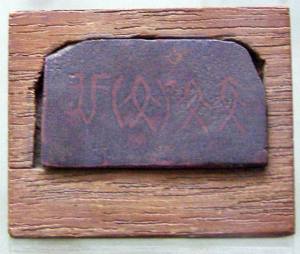 B
B

 Dilmun Seals: Persian Gulf find sites. "
Dilmun Seals: Persian Gulf find sites. "


















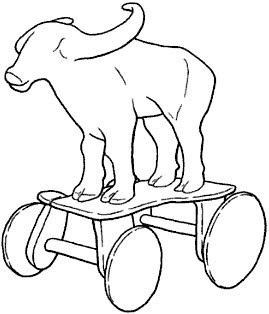







 "Coppersmith barbet is one bird that is easiest to identify. It has a round shade yellow face and throat. The body, light green upper part and dark green streak on pale yellow under part. Then a black stripe across the eye." http://www.drkrishi.com/coppersmith-barbet-3/
"Coppersmith barbet is one bird that is easiest to identify. It has a round shade yellow face and throat. The body, light green upper part and dark green streak on pale yellow under part. Then a black stripe across the eye." http://www.drkrishi.com/coppersmith-barbet-3/

















 m1429b
m1429b m1429a
m1429a




 Harappa. Burial urn. Kenoyer Slide 164
Harappa. Burial urn. Kenoyer Slide 164 Figure of a person is ligatured within the body of the peacock with a wavy plume (first peacock on the right); The person shown within the circle is probably the depiction of the departed a_tman, who has, after cremation, become an ancestor. The stylized depiction of the arms is paralleled by the stylized depiction of arms (or horns?) of the copper anthropomorphs found in Copper Hoard Culture.
Figure of a person is ligatured within the body of the peacock with a wavy plume (first peacock on the right); The person shown within the circle is probably the depiction of the departed a_tman, who has, after cremation, become an ancestor. The stylized depiction of the arms is paralleled by the stylized depiction of arms (or horns?) of the copper anthropomorphs found in Copper Hoard Culture.







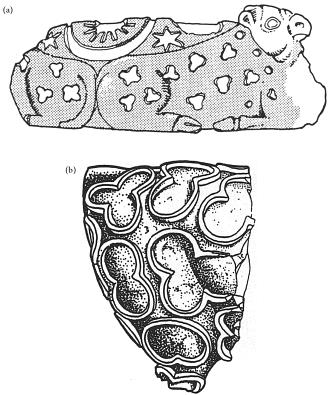
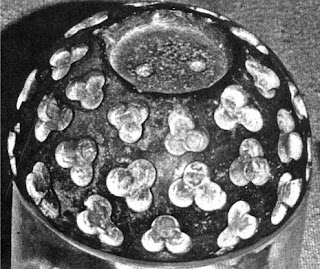

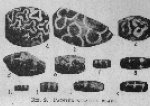



 Two decorated bases and a lingam, Mohenjodaro.
Two decorated bases and a lingam, Mohenjodaro. 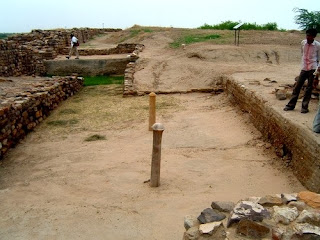 A pair of Skambha in Dholavira close to kole.l'smithy, temple' ( (8-shaped stone structure):
A pair of Skambha in Dholavira close to kole.l'smithy, temple' ( (8-shaped stone structure): 



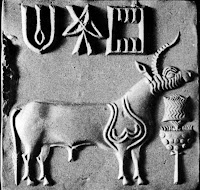




















 Figure 1. Map of Iran, with Jiroft, Konār Ṣandal, and sites of the 3rd millenium BCE with chlorite vessels.
Figure 1. Map of Iran, with Jiroft, Konār Ṣandal, and sites of the 3rd millenium BCE with chlorite vessels. Tepe Yahya/Jiroft frieze. Zebus and lions. A zebu gores a lion (the zebu seems to be then on the verge of domestication, Figure 7f.
Tepe Yahya/Jiroft frieze. Zebus and lions. A zebu gores a lion (the zebu seems to be then on the verge of domestication, Figure 7f. c. 2900 BCE. Khafajah. The best known of the chlorite bowls is from Khafajah; it is of Mesopotamian manufacture. •A man kneels upon the hindquarters of one of a pair of standing zebu bulls facing away from each other. In each hand he holds a stream of water which flows over the head and finishes in front of each bull. Plants grow from the right stream, plants grow behind the left bull, and a plant grows in front of each bull. Above the man are a rosette, a crescent and (possibly) a snake. Above the left stream is some sort of carnivore, perhaps a panther.
c. 2900 BCE. Khafajah. The best known of the chlorite bowls is from Khafajah; it is of Mesopotamian manufacture. •A man kneels upon the hindquarters of one of a pair of standing zebu bulls facing away from each other. In each hand he holds a stream of water which flows over the head and finishes in front of each bull. Plants grow from the right stream, plants grow behind the left bull, and a plant grows in front of each bull. Above the man are a rosette, a crescent and (possibly) a snake. Above the left stream is some sort of carnivore, perhaps a panther. 
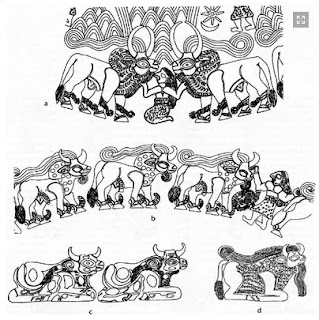










 Examples of metalwork from Sheffieldd of Indus civilization: Chanhu-daro.'Sheffield of ancient India' Chanhujo-daro metal artefacts (Illustrated London News 1936, Nov. 21)
Examples of metalwork from Sheffieldd of Indus civilization: Chanhu-daro.'Sheffield of ancient India' Chanhujo-daro metal artefacts (Illustrated London News 1936, Nov. 21)





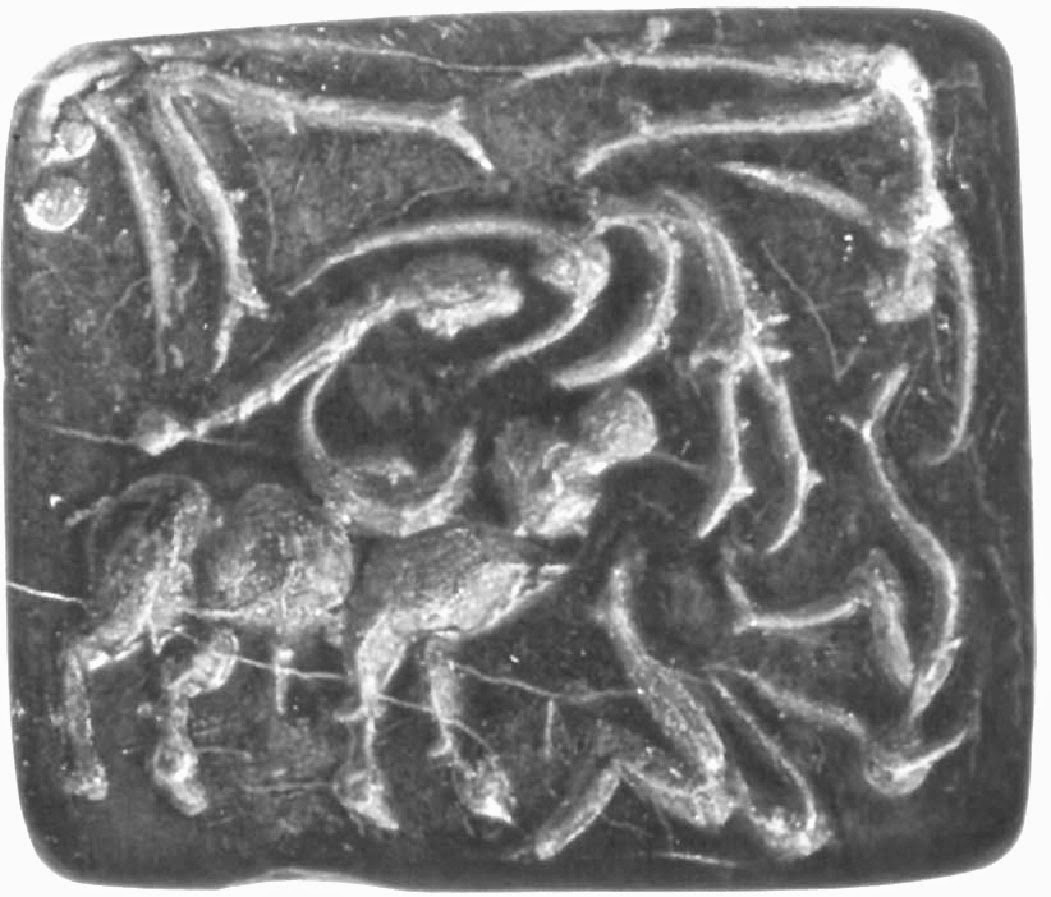



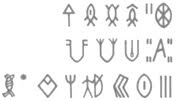

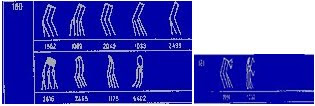










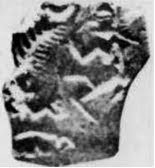








 m478B
m478B

![clip_image062[4]](http://kalyan97.files.wordpress.com/2007/06/clip-image0624-thumb.jpg?w=99&h=45)

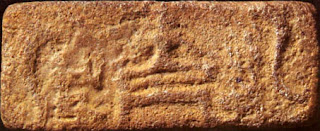




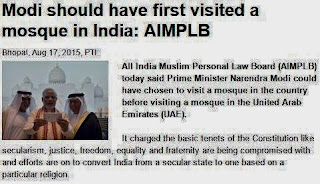





























 A pair of ingots with notches in-fixed as ligatures.
A pair of ingots with notches in-fixed as ligatures.
















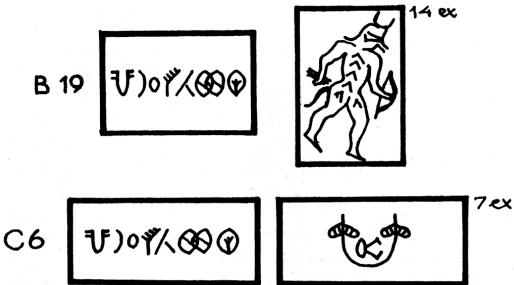







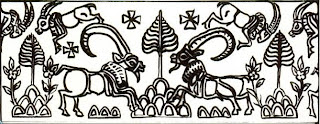
 m0296 See:
m0296 See: 


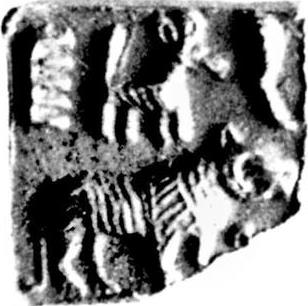
 Banawali. Seal B 17 Horned tiger in front of sangaDa 'lathe, portable furnace'
Banawali. Seal B 17 Horned tiger in front of sangaDa 'lathe, portable furnace'







 (E. Douglas van Buren.
(E. Douglas van Buren. 







 Seal. Kalibangan K-50
Seal. Kalibangan K-50


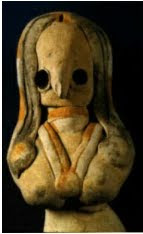
 harappa.com "Slide 88. Three objects (harappa.com)
harappa.com "Slide 88. Three objects (harappa.com) 

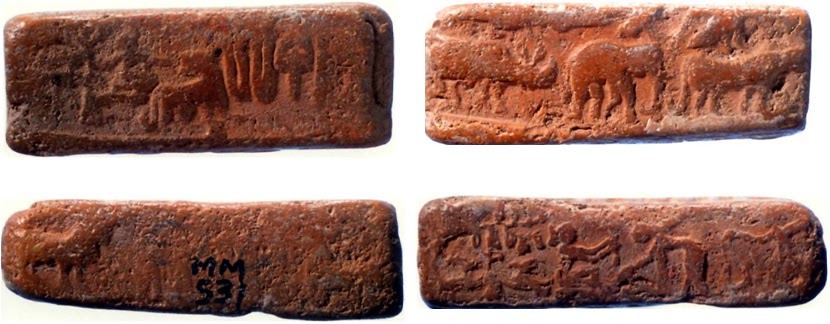












 Image on Ngoc Lu bronze drum
Image on Ngoc Lu bronze drum














 The market was spooked by the fact that Monday's plunge was the sharpest since the 7.25 per cent drop on January 7, 2009, that had been triggered by Satyam founder B. Ramalinga Raju's admission that he had padded profits at the software giant.
The market was spooked by the fact that Monday's plunge was the sharpest since the 7.25 per cent drop on January 7, 2009, that had been triggered by Satyam founder B. Ramalinga Raju's admission that he had padded profits at the software giant. Later in the evening, Jaitley said Prime Minister Narendra Modi had started monitoring the situation on the stock and currency markets and indicated that the government would not hesitate to adopt a slew of measures to stabilise the situation.
Later in the evening, Jaitley said Prime Minister Narendra Modi had started monitoring the situation on the stock and currency markets and indicated that the government would not hesitate to adopt a slew of measures to stabilise the situation.

Reply
Reply
Reply
Reply
Reply